ISSUE 5
IT'S ONLY NATURAL
How regenerative farming is safeguarding luxury fashion
SOCIAL SHIFT
Tech entrepreneur Sue Fennessy on rethinking social media

IT'S ONLY NATURAL
How regenerative farming is safeguarding luxury fashion
SOCIAL SHIFT
Tech entrepreneur Sue Fennessy on rethinking social media
As The Australian Ballet celebrates 60 years on stage, artistic director David Hallberg is poised for the future
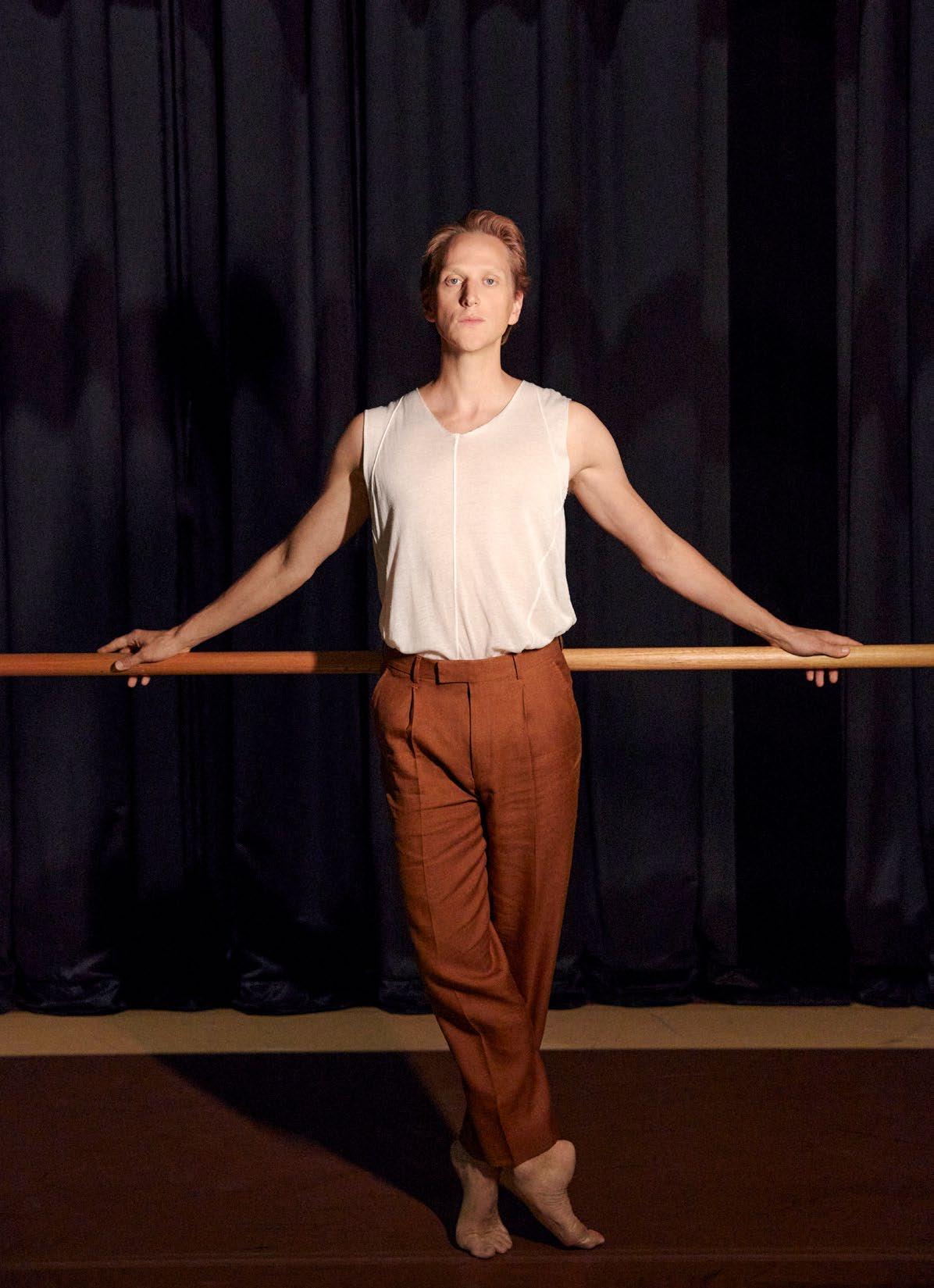
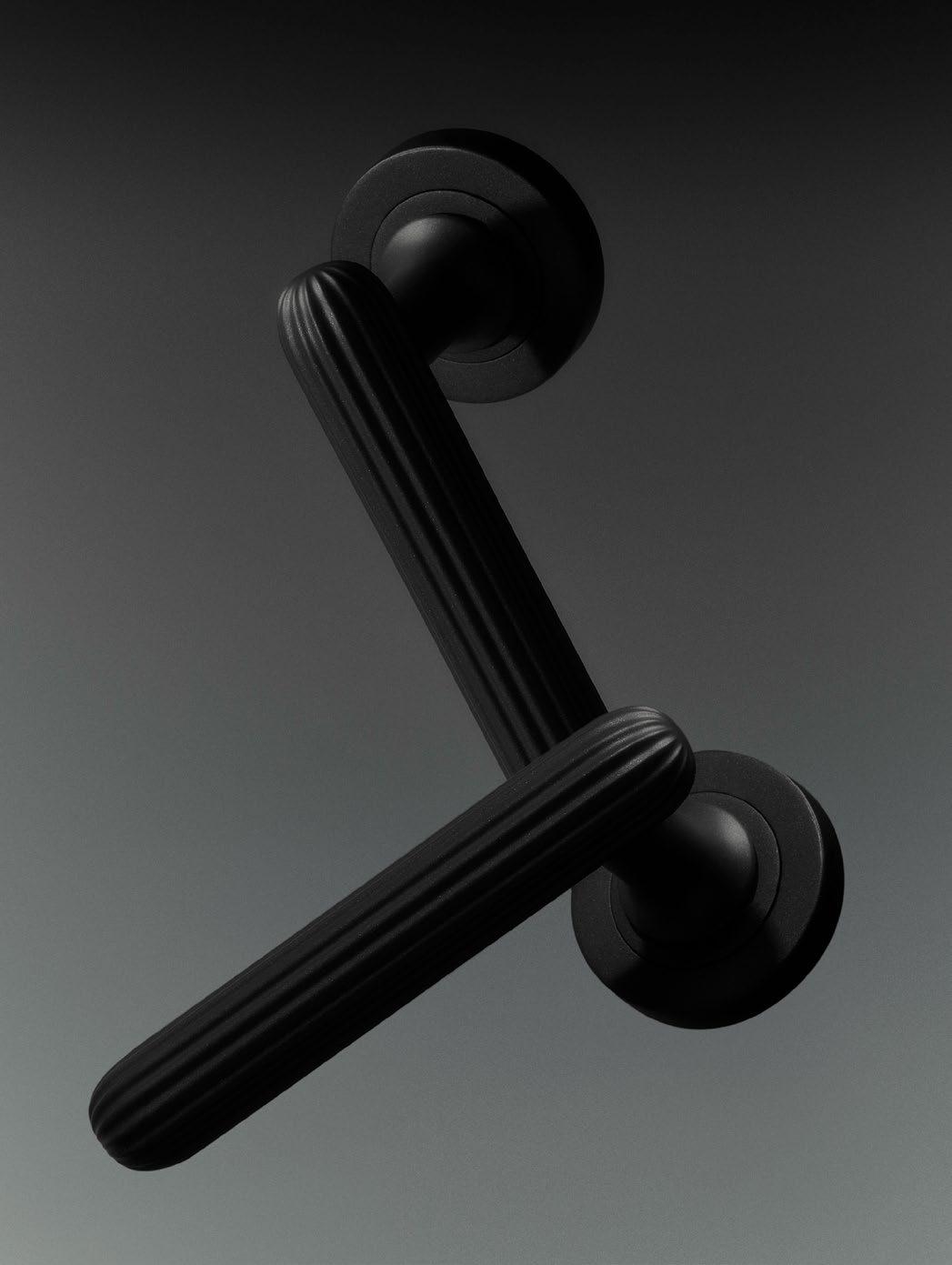

‘THE EXCEPTION’ BY POMMERY



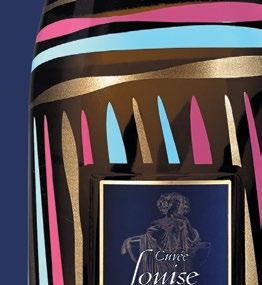

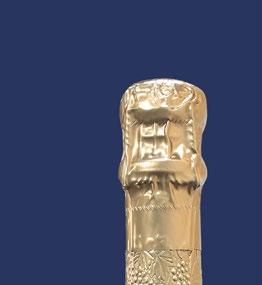


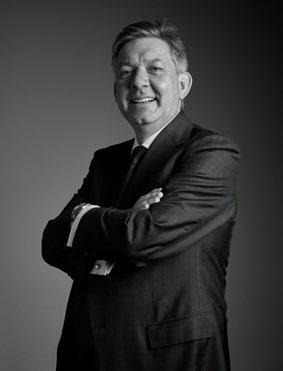
As specialists in prestige property, we know that luxury is less about shiny veneers than it is the spaces, objects and people that enrich your everyday. Luxury is derived from quality, that elusive commodity resulting from deep-rooted knowledge and meticulousness, which can seem at odds with the relentless acceleration of modern life.
As we race to meet the future, we find ourselves talking casually of things that seemed abstract concepts not so long ago, from artificial intelligence and smart homes to 3D-printed furniture and flying cars. This issue of The Luxury Report reveals that when faced with questions about what comes next, many of us are responding by looking to rituals of the past. As life seems to become busier and more urgent, the rush is being countered with intention and self-reflection as well as innovation.
Such is the case for artistic director of The Australian Ballet, David Hallberg, who talks to Jane Albert about what audiences can expect as the institution enters its 60th year on the stage (p.36). Hallberg paints an enticing picture of how we can draw from the rich traditions of such an artform without neglecting contemporary obsessions or failing to evolve. He is photographed for this issue’s cover story backstage at the Sydney Opera House, another Australian stalwart celebrating a milestone this year.
A signal of our own cycle of innovation and renewal can be seen in Kay & Burton's brand architecture, which we have reimagined this year to better encapsulate the contemporary and considered nature of our offering. It is only by continually evolving our business and refining the promises we make to our clients and broader community that we can remain the trusted advisor for the most coveted property in the country from one generation to the next. I hope you enjoy both the new look and feel of Kay & Burton communications and appreciate the vigour and clarity with which we are approaching our role in 2023.
Beyond our own backyard, we survey the realms of art, architecture, food, travel, business, tech and economics to uncover emerging trends and highlight some of the people and ideas shaping our future. We gain insight into the rise of the restomod (p.32), which sees classic car models reconfigured with cutting-edge engineering, and talk about the tipping point for electric vehicle adoption with energy titan Trevor St Baker, including when we can expect airborne taxis to be a fixture of the cityscape (p.10). We also speak to UK-based Australian tech innovator Sue Fennessy, who is shaking up social media with a new platform that seeks to recover the values of community, connection and creativity that fuelled the rise of the sector in the first place (p.48).
Elsewhere, we look at the influence of ancient knowledge systems on the work of Argentinian artist Tomás Saraceno, currently exhibited at Brisbane’s QAGOMA and Hobart’s MONA (p.26), and explore how regenerative farming practices are driving new measures of success for both luxury fashion houses (p.06) and Australia’s oyster industry (p.52). Moving from home soil, where we ponder the perennial supply crunch at the premium end of the property market (p.44), we examine the upswell of interest in travel experiences that foreground cultural and personal renewal (p.58).
To my mind, the passion for progress that pours out of these stories cannot help but push us to think differently and see our lives anew, without losing sight of the small joys and traditions that have defined us up to this moment in time. Whether you consider yourself a first mover or a fast follower after perusing this edition, I trust you agree that the view from here is a fascinating one.
06 IT’S ONLY NATURAL
From cotton to cashmere, discover how high-end fashion houses are rethinking their fabric production processes to redefine luxury.
10 POWERING UP
Energy baron Trevor St Baker shares his take on the future of city transport and building a business that can flourish across generations.
14 DESIGN IN DIALOGUE
Niccolò Mazzei of Italian furniture house Edra discusses merging family with business and the importance of respecting innovation and tradition.
26 SHIFTING AIR
Existing at the intersection of physics, nature and art, the work of Argentinian artist Tomás Saraceno imagines bold possibilities.
30 CITY GUIDE: TOKYO
Chef Michael Ryan opens his little black book of gastronomic gems and cultural experiences in the Japanese capital.
32 RISE OF THE RESTOMOD
The collectable car phenomenon that is seeing die-hard enthusiasts drive back to the future—in strictly limited numbers.
44 IN HIGH DEMAND
The race for space is on as supply of Australian ultra-luxe properties becomes tighter than ever. Here, we unpack why.
56 TOWARD THE LIGHT
MPavilion designer Rachaporn Choochuey on the power of temporary design and adaptable architecture.
58 SLOW SOPHISTICATION
In travel, Europe’s burgeoning rail renaissance is part of a post-pandemic focus on low-carbon journeys and cross-cultural immersion.
62 OUT AND ABOUT
Explore the Peninsula’s new relaxation destination, a one-night chance to see a maestro in his final season, plus the latest restaurant and exhibition openings.
Can social media be ethical? Meet the Australian woman challenging big tech with a platform that puts people first.
A historic timepiece revamped, the year’s most anticipated fashion launch, a skilfully sculpted dining table and more.

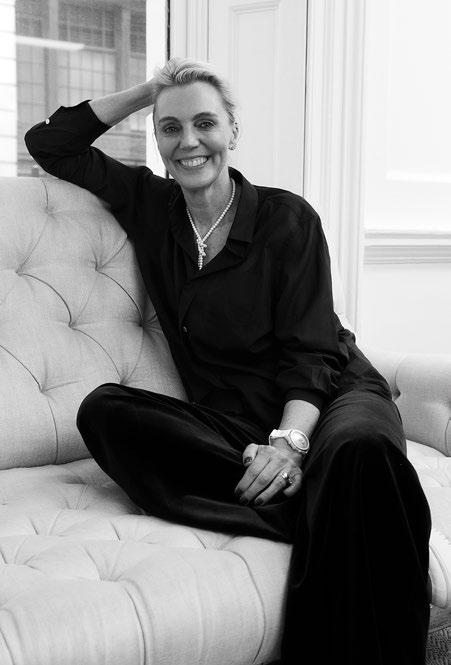
Three leaders in residential architecture discuss how they achieve the elusive balance between sustainability and aesthetics.
While Australia’s marine ecosystems are facing multiple challenges, oyster farming is providing some worthy (and ultimately delicious) solutions.

David Hallberg, artistic director of The Australian Ballet, shares his vision for interpreting the national dance company’s beloved classical repertoire.

NAB
Mark Browning
Head of Property Service Group
KAY & BURTON
Ross Savas
Managing Director
Peter Kudelka
Executive Director
Gowan Stubbings
Executive Director
Alex Schiavo
Executive Director
Scott Patterson
Executive Director
Tom Barr Smith

Executive Director
Liz Jensen
Portsea & Sorrento Director
EDITORIAL
Managing Editor
Luke McKinnon
Editors
Emma Pegrum
Carlie Trotter
Art Director
Aaron Dunn
Writers
Jane Albert
Rosa Bertoli
Leanne Clancey
Kirsten Craze
Kyle Fortune
Daniela Frangos
Catherine Gillies
Brodie Lancaster
Louise Martin-Chew
Isla Sutherland
Lucianne Tonti
Design Stories we tell
Louis Vuitton: Charlie sneaker. Eco-innovation meets understated style in this debut unisex sneaker by Louis Vuitton. Dubbed ‘Charlie’ (a popular genderless name in America), this Italian-made shoe is available in both low and high-top versions, delivering a modern androgynous aesthetic. Made from 90 per cent recycled and bio-sourced synthetic materials, the Charlie features the iconic LV monogram pattern under the outsole, while the tongue patch—composed entirely of recycled nylon material—reveals a modernised, sans serif LV logo. From $1630. au.louisvuitton.com

Assouline: The Impossible Collection of Champagne book. In homage to one of the world’s most celebrated celebration drink, this collectable tome chronicles three centuries and 100 bottles of the greatest Champagne ever produced. Curated by award-winning, Paris-based sommelier Enrico Bernando, the book covers a selection of remarkable vintages and exceptional recent releases, presenting a trove of historical photographs and exclusive tasting recommendations sure to impress any French fizz fanatic. The newest release in Assouline’s 25-book ‘The Impossible Collection’ series, this exclusive hand-bound edition features hand-tipped labels and a wooden display box. Due to launch on phoebephilo.com in September 2023 with registration from July.

Cartier: Tank Française watch. A modern interpretation of the signature accessory worn by the likes of Princess Diana and Jackie Kennedy, this yellow gold, diamond and quartz-crafted timepiece breathes new life into the legacy of the classic Tank Française design. Most notable updates include softer, rounder curves on the crown and the 27 cut diamonds (totalling 1.22 carats) engraved into the brancards. The beauty and tradition of the design are maintained in the watch’s timeless chain-linked bracelet, classic rectangular crown and distinctive 30-degree slanted numerals. $46,300. cartier.com.au


Phoebe Philo announces Eponymous. Ending years of widespread speculation, doyenne of high fashion, British designer Phoebe Philo will return from a six-year hiatus later this year to release her highly anticipated inaugural collection, Eponymous. As the name indicates, the direct-to-consumer label (backed by LVMH), is projected to feature Philo’s signature monochromatic colour schemes and gender-neutral pieces, reminiscent of work from her decade-long tenure as creative director of Celine. Due to launch on phoebephilo.com in September 2023 with registration from July.
Paola Lenti: Altopiano dining table. Crafted from moulded, glazed porcelain stoneware, this striking dining table was selected as one of the year's top new products in the 2022 Stylepark Selected awards. Conceived by Italian designer Robin Rizzini, the skilfully sculptural piece is composed of ethically processed stratified glass and available in various forms and colours. The table’s interchangeable handcrafted accessories offer scope for customisation, adding a personal touch to each piece. From $24,270. dedece.com
 04.
04.
In a fashion world dominated by mass production, cheap synthetic materials and ever-present digital marketing, true luxury is being redefined by a return to basic principles: the beauty and wonder of nature.
– By Lucianne Tonti“Luxury is at the intersection of nature and creativity.” It was 2021 when Antoine Arnault, the head of communications and image at Moët Hennessy Louis Vuitton (LVMH), said this, as luxury fashion’s attitude towards sustainability was undergoing a rapid transformation.
Among the upper echelons of fashion design, where products are often crafted from the rarest and finest natural materials, an existential threat to business had been identified. In a world without healthy plants and animals, there would be no cotton shirts, wool coats, cashmere sweaters, leather handbags or silk dresses.

Around the world, brands including Gucci, R.M. Williams and Loro Piana are making moves to safeguard their raw materials by protecting and restoring the farms, rangelands and forests where they are grown. The hope is that increased biodiversity and soil health will safeguard the supply of natural fibres from rising global temperatures, unpredictable weather patterns, desertification and deforestation.

The new strategy marks a step away from the usual “sustainable fashion” approaches, which focus on harm mitigation, instead moving towards regenerative practices that actively improve landscapes and livelihoods. Over the past 18 months, two global luxury behemoths—Kering and LVMH—have separately announced a range of initiatives to protect, restore and rehabilitate biodiversity, with an emphasis on implementing regenerative agriculture where raw materials are farmed.
Advocates for regenerative agriculture claim that vibrant ecologies produce more beautiful materials. In Australia and New Zealand, sheep farms that nurture grass supply alongside the careful management of native forests and their supporting ecosystems produce the world’s finest merino wool. The grass and other foliage provide a constant source of nourishment so fleece growth is smoother and more consistent. The softest cashmere comes from the undercoat of goats roaming the rangelands of Mongolia, where the difficult and wild terrain determines the fineness of the fur and herders have worked with the rhythms of the land for generations. Since luxury depends not just on the supply of raw materials but on the supply of raw materials of the highest quality, the narrative is powerful.
As we race towards a future driven by mass production, cheap synthetic materials and ever-present digital marketing, true luxury is being redefined. The expendable and the artificial have been replaced by a return to basic principles and a deeper appreciation for the beauty and wonder to be found in nature. After all, on a dying planet, what could be more luxurious than taking refuge in green
rolling fields, dense forests, sparkling rivers and air so clean it smells like the earth? As Francois-Henri Pinault, chairman and CEO of Kering, states: “Luxury and sustainability are one and the same.”
This shift in intentions culminated in December 2022 at COP15, the United Nations Biodiversity Conference in Montreal, where Kering—the parent company of Gucci, Bottega Veneta, Yves Saint Laurent, Balenciaga and others—joined LVMH to push for an official global biodiversity framework. Géraldine Vallejo, Kering’s sustainability programme director, told the event: “It’s the first biodiversity COP where the private sector is really present and pushing for an ambitious global biodiversity framework… We are hoping that the negotiators will agree on the level of ambition that is necessary. We also expect that next year the fashion sector will have its own dedicated stream [at the conference].”
The attendance of these fashion giants at the summit was followed by several announcements outlining new initiatives centring on biodiversity and regenerative agriculture. In partnership with L’Occitane, Kering launched a scheme to fundraise €300 million from luxury fashion and beauty companies to invest in nature conservation and restoration initiatives. The fund is also looking to help farmers transition to regenerative agriculture and support community projects promoting women’s empowerment. Meanwhile, LVMH, which controls Christian Dior, Fendi, Givenchy, Celine, Stella McCartney and Loro Piana among others, announced it would launch a program with UNESCO to restore forest cover in the southern Ecuadorian and northern Peruvian Amazon and strengthen the development of a regenerative economy in the region’s Indigenous communities.
Both announcements follow earlier commitments from the two conglomerates to use regenerative agriculture to rehabilitate millions of hectares along their supply chains.
Of course, intentions to put nature first sound poetic and persuasive, but fashion accounts for between two and eight per cent of global greenhouse gas emissions and commits a range of other
environmental offences, from polluting waterways and degrading topsoil to deforestation. Given the industry’s history of using and abusing the lands and people along its supply chains, it might be hard to believe that farming raw materials could be a force for good but regenerative agriculture campaigners say it has the potential to restore damaged farmland in as little as five years. US-based global not-for-profit Textile Exchange describes the shift to regenerative agriculture as “fundamental to the long-term health of the fashion and textile industry”.
As the fashion industry grapples with reducing its carbon footprint, the term ‘regenerative’ has begun popping up with more frequency in marketing campaigns. At times, it is applied as liberally as “eco-friendly”, “sustainable” or “natural”—words with vague meanings often used by brands to greenwash their products. But when measured by clearly defined metrics, the outcomes of true regenerative farming are much less nebulous.
The simplest way to define regenerative agriculture is as a type of beyond-organic farming, a holistic approach to land management that works with nature rather than trying to control it. On a regenerative farm, traditional principles of industrial agriculture— spraying pesticides and synthetic fertilisers, tilling the soil and planting only one type of crop—are avoided. In their place, farmers use a range of techniques to improve the land across four key metrics: biodiversity, soil health, water infiltration and outcomes for communities.
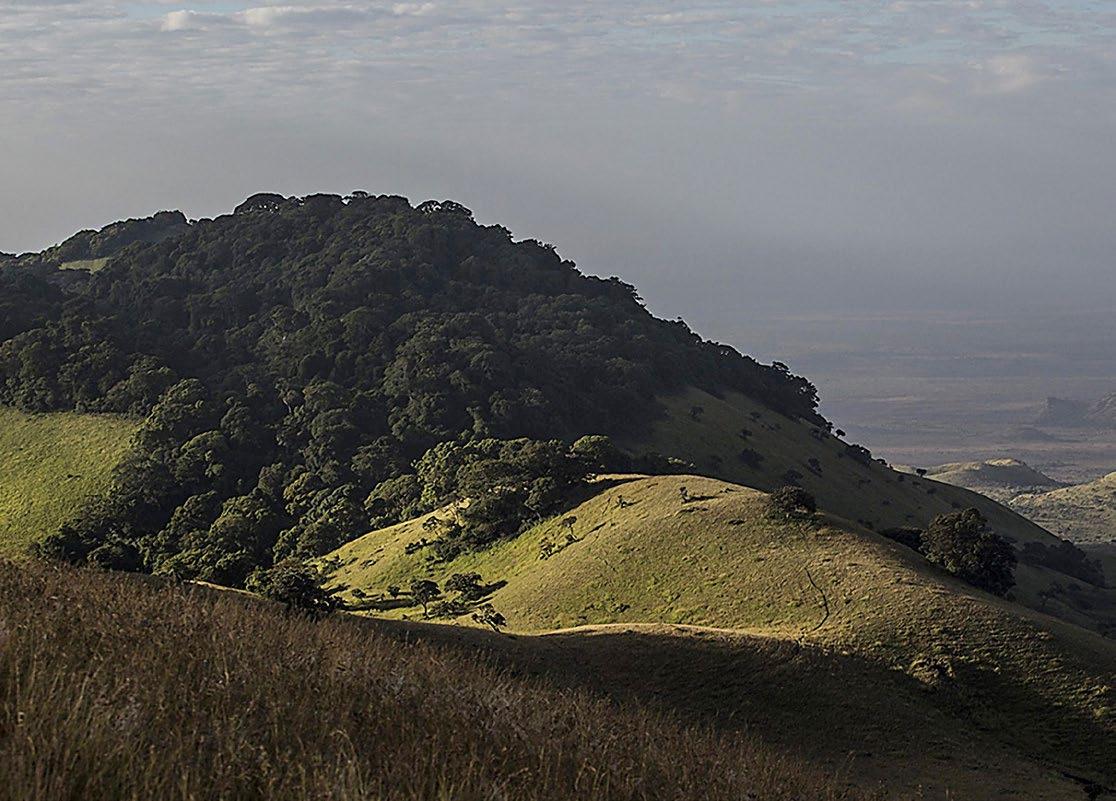
A regenerative farm should look and feel wild, like a pasture with different species of plants, animals and insects all working in harmony. As in nature, where there is rarely bare soil, a regenerative farm will ensure the ground is covered at all times, reducing the
soil’s vulnerability to erosion and from being dried out by the sun. Regenerative farmers plant cover crops to protect the soil, restore healthy microbial life and prevent weeds and pests. These crops are later mulched into the ground to return their nutrients to the soil.
In addition, the regenerative approach will see multiple species of complementary crops planted in the same field—perhaps chickpeas tangled beside cotton plants or tomatoes growing alongside hemp—with companion planting replacing chemical pesticides as a way to lure pests away from the main crop. Lines of trees and hedges encourage native birds and wildlife to inhabit the environment. Chickens, sheep and cattle might roam the fields, their manure fertilising the soil. The landscape should visibly and audibly brim with life.
These principles are not new. Before the invention of chemical fertilisers and farming machinery, farmers relied on natural cycles to grow their crops, with principles of land stewardship and deference to the power of nature having long been central to many indigenous communities. However, the large-scale application of these practices to fibre farming is still nascent, making the investment from Kering and LVMH significant.
Through a recent partnership with the King Charles III-founded Circular Bioeconomy Alliance, LVMH is developing a sustainable cotton production project in Africa led by regenerative and restorative principles. Commonly grown as a large-scale monocrop using industrial agriculture techniques, cotton can be especially resource-hungry, thirsty and polluting. But as we are now learning, the fibre can, in fact, be farmed in ways that enhance soil health and biodiversity.
Following a regenerative agroforestry system, the LVMH program will work with 500 farmers in Chad, northern central Africa, to plant fruit and timber trees alongside their cotton crops. Designed to improve soil fertility and water retention, provide shade and fodder for livestock, and offer a protective cover that enhances biodiversity, the trees have the added advantage of generating alternative income and subsistence for the farmers.
The notion that regenerative farming can improve the lives of farming communities is central to transforming the fashion industry’s supply chains. Potential benefits for farmers are manifold, from generating additional revenue streams and retiring expenditure on fertilisers and pesticides, to improving physical health by reducing exposure to toxic chemicals. However, the transition to regenerative agriculture takes time, and having set a target to preserve 5 million hectares of farmland by 2030, LVMH’s longterm commitment to train farmers in the principles of regenerative agriculture will be fundamental to achieving this goal.
One of Kering’s regenerative programs is a partnership with US-based organisation the Savory Institute to expand networks of holistic grazing of wool, cashmere and leather along fashion’s supply chains. While livestock can be a significant contributor to greenhouse gas emissions and a leading cause of desertification, these issues are usually the result of intensive feed-lots and “set stocking”—a grazing strategy where livestock are left in a single paddock for an extended time, eating the grass right down to its roots, causing it to die, with the soil becoming hardened and compacted as a result.
The alternative is a holistic grazing technique developed by farming pioneer and founder of the Savory Institute, Allan Savory, which has been proven to regenerate grasslands and sequester carbon into the soil. When animals such as sheep or cows are herded close together and moved on quickly, the combination of their hooves (which scuff up the grass so seeds are planted), their manure (which fertilises the soil) and their mouths (which help stimulate growth in plants) means that wool, cashmere and leather farming can all play a role in improving soil health and biodiversity while restoring habitats.
The application of Savory’s holistic grazing principles is becoming increasingly widespread, with Italian fashion house Gucci, one of the brands under the Kering umbrella, embracing the approach. The brand is working with woolgrowers in Patagonia to help convert to regenerative grazing on grasslands in a bid to promote soil health and water quality, increase biodiversity, and establish best practices for animal welfare and carbon sequestration for the long-term. Closer to home, Australian brand R.M. Williams recently set a commitment to halve the carbon footprint of its iconic boots by integrating regenerative grazing practices into its leather supply chains. Elsewhere, Italian apparel label Loro Piana has been working closely with goat herders in Mongolia and Inner Mongolia to ensure the protection of the regions’ eco-systems and native species to help maintain the quality of their cashmere.

Products of the natural world are the industry’s most essential resources; providing comfort, tactility, beauty and awe, natural fibres are the very building blocks of luxury. In 2005, then-CEO of Loro Piana, the late Sergio Loro Piana, stated that “nature is hard to reinvent”—a sentiment that is now at the heart of the industry’s focus on regenerating natural environments and protecting biodiversity. Indeed, without nature, it could be said that luxury would cease to exist. Perhaps the only surprising part of this equation is that it was ever forgotten.
 01. The rugged Flinders Ranges provide the inspiration for R.M. Williams' latest consumer campaign highlighting its ultra-durable, minimal-waste approach to leather craftsmanship.
02. More sustainable farming methods for cotton—the world's most popular natural fibre—are being prioritised to bolster ecosystem health.
01. The rugged Flinders Ranges provide the inspiration for R.M. Williams' latest consumer campaign highlighting its ultra-durable, minimal-waste approach to leather craftsmanship.
02. More sustainable farming methods for cotton—the world's most popular natural fibre—are being prioritised to bolster ecosystem health.
We sat down with the
– By Carlie TrotterFew investors could claim as monumental a year as the St Baker Energy Innovation Fund (StBEIF), the venture capital firm established by Trevor St Baker a decade ago to help stimulate early-stage companies supporting the transition to clean energy. In addition to listing two Brisbane-born businesses on the Nasdaq—battery tech developer Novonix and electric vehicle (EV) fast-charger manufacturer Tritium—the fund also made its first foray into aviation via air taxi startup Vertiia, which last month celebrated the maiden flight of the first electric vertical take-off and landing (eVTOL) vehicle designed and built in Australia. At the same time, St Baker made a wellpublicised exit from the coal power sector with the sale of the Vales Point plant in New South Wales via a nine-figure deal that saw him climb Queensland’s list of homegrown billionaires. The opening of Tritium’s first factory on American soil turned heads too, the imminent launch of a third production line putting the facility on target to deliver 30,000 direct-current charging stations per year by 2025.
One could therefore be forgiven for thinking the mega-entrepreneur might want to slow down a notch this year, but in fact, he is casting an even wider net and looking further into the future. At the time of writing, for example, his eponymous fund (an early-stage venture capital limited partnership) is about to close its first ever capital raise, bringing likeminded investors beyond the extended St Baker family into the fold to better progress his vision of widespread e-mobility. If anything, the work of the StBEIF is about to speed up.
“We are trying to create an innovation hub,” explains Trevor St Baker, fresh from appearing on a smart cities summit panel. “California has Silicon Valley, and we have Fortitude Valley; the rest of Australia hasn’t woken up to Queensland while we’re building the R&D headquarters of this multimillion-dollar global company [in Tritium] right here in Brisbane, with more than 120 engineers among its 500-strong workforce.”
He continues: “We’ve got to encourage people with new ideas and bring in the skills and discipline they need to move from the device end to the cash end, which isn’t about making money overnight. Business success isn’t made with money, it’s made through the application of knowledge and experience.” The investment philosophy of the StBEIF focuses on supporting market disruptors that are likely to pay dividends over an eight-year horizon if the domain expertise of the board can be brought to bear. Having founded and run one of Australia’s major electricity retailers in ERM Power, before selling to Shell Energy in 2019, it is safe to say St Baker’s expertise played a key part in taking Tritium from a niche outfit serving the solar car racing industry to the biggest supplier of EV fast chargers to the US and second-biggest in Europe.
The fact that Australian innovations are so often overlooked until they achieve success overseas is no small source of consternation for St Baker, but he remains indefatigable. A fellow StBEIF-backed company, charge point operator Evie Networks, has partnered with the Australian Renewable Energy Agency to deploy hundreds
Solving the problems of our transportation system and accelerating decarbonisation may sound like Herculean labours to most of us, but for energy titan Trevor St Baker AO they are the stuff of the daily to-do list.
Brisbane-based businessman to reflect on his 60 years in the power industry—and get the inside scoop on ushering in a world of flying cars.
of Tritium chargers across the country this year. “It’s going to happen, no one is designing internal combustion engines anymore,” he says of the tipping point in EV uptake we arguably find ourselves at. “The world wasn’t quite ready [for electric cars] when I bought my first Nissan Leaf back in 2011, but now everyone knows that their next car or the one after that will be electric because the fueling and maintenance costs using off-peak power are about a sixth of a petrol car.” He adds that luxury EVs like Rolls Royce’s Spectre “making EVs seem sexy” doesn’t hurt either, though he is personally happy to stick with his trusty Nissan and a Tesla Model 3.
Another project about which he can barely contain his excitement, the details of which are still being finalised, would see the fund’s electrification businesses work together and in league with local councils to decarbonise some of Australia’s remotest corners. “We call it turnkey decarbonisation because we could provide everything to fuel an all-electric vehicle network, including leveraging surplus power from rooftop solar for industries like fishing,” enthuses St Baker.
He is not deterred by the prospect of challenging major players either. “We’re investing in a couple of really interesting companies in the realm of autonomous vehicles,” he says, “which is a long shot when the likes of Tesla and Ford are playing in this space, but if there is a chance of creating Australian jobs, we’re going to take it.” Meticulously mapping our power and road infrastructure needs into the 2040s has also led to his throwing support

behind the proposal for a $6bn tunnel connecting the end of the Inland Rail in Brisbane’s outer suburbs to the Port of Brisbane via driverless electric shuttle, taking thousands of trucks off the city’s roads each year and helping to improve air quality. But that is not enough, he posits, because there is another way to reduce the high-emission vehicles clogging our roads: take to the sky.
The zero-emission box-wing Vertiia is billed by Sydney-based AMSL Aero as the longest-range “flying car” in the world, able to travel three times further on battery and hydrogen power than its competitors and offering the door-to-door advantage of a helicopter with lower operating costs and noise levels. “We're taking a risk by competing with superbrands like Boeing but the patents give this prototype an edge and the Australian Defence Force is co-funding its development because of the aeromedical and cargo applications in a spread-out country like ours,” says St Baker. “We need to take advantage of this ability to land safely [in the urban environment] because we simply can't keep building more roads.”
He continues: “Boeing already has the 2028 Los Angeles Olympics covered but it’s my vision that the 2032 Brisbane Olympics is when eVTOLs officially reach maturity while the whole world is watching. Will we see all the athletes arriving at the Gabba in Vertiia eVTOLs? We very well might, it is a plausible dream.” Pending certification by the Civil Aviation Safety Authority, Vertiia is predicted to reach the market in 2026.
Continually casting his attention on the world of tomorrow, and now in his mid-80s, it is hardly surprising that Trevor St Baker is increasingly preoccupied with succession. While he jokes that his independently minded children make nepotism impossible, and that one in eight grandchildren following him into the business is not a particularly good ratio, the patriarch says he has heartily supported them sitting on the boards of StBEIF ventures so they can talk through questions and suggestions as a family while he is still heavily involved. His sons Philip (founder of Novonix) and Stephen (a founder of Pure-EVs and director at StBEIF) have long been immersed in the dayto-day of course, while granddaughter Amelia is making her mark on the portfolio’s wearable therapeutics concern, CareWear, but the St Baker Energy Innovation Fund is more corporation than family business these days.
“Entrepreneurship isn't inherited and our success relies on our staff members, so we have to continue taking care of them as well as directing the business in a way that honours our commitments and effectively balances investments that have a solid chance of return with the higher risk ones that we [feel compelled to] explore,” he says. In addition to placing heavy significance on employee share schemes, St Baker says regular “over the horizon” conversations—where company leaders and their teams rigorously debate and plot out different scenarios—are essential to cultivating future-mindedness and, ultimately, business success.
He adds: “The world doesn't keep turning because of government ministers or business leaders; it goes around because of everybody doing their bit day in, day out, and thinking about how they might improve their contribution.” Making sure the wider team feels part of the journey and safeguarding long-established relationships is clearly important to St Baker as he considers passing the baton. It is unsurprising then, that he has banked continuously with both the business and private wealth divisions at NAB for over 40 years, dating back to the early days of ERM Power and its floating on the ASX. Today, the bank helps
to steward the finances of a far larger St Baker clan than was the case in the 1980s, including a widening range of philanthropic interests.
“When we have the ability, we have an obligation to give back,” says St Baker, adding that his wife Judith is the naturally proactive philanthropist where he has been more focused on nurturing talent through student scholarships and university fellowships. “Our past investments have stemmed from self-interest, such as funding melanoma research after I discovered two of them on myself,” he demures, the same month that the St Baker Family Foundation committed to another five years of funding for the St Vincent de Paul Society to aid women experiencing homelessness.
He jests that his own age-related health challenges inform the interest of the St Baker Energy Innovation Fund in brands like CareWear, which produces red light therapy patches that use photobiomodulation technology to treat pain, and Vald, a maker of devices that assess musculoskeletal health and injury rehabilitation. “Aside from elite sports, there are big opportunities for new technologies like these in sectors like aged care, and next we’re exploring the use of photobiomodulation in combatting wrinkles, it’s quite fascinating,” he explains.
Though he often talks about luck and describes accolades such as being named an Officer of The Order of Australia in 2016 as “out of the blue”, those who work alongside Trevor St Baker say it is his forensic attention to detail, people-oriented leadership and the culture of continuous improvement that he fosters—rather than any twist of fate—that has secured his legacy.
Indeed, his perspective on the race to commercialise flying cars seems to sum up his modus operandi more generally; “I would like to be in the vanguard and see where Australia can take its innovations, not simply wait on our counterparts in America or elsewhere to come out with the next big thing.”
stbenergy.com.au
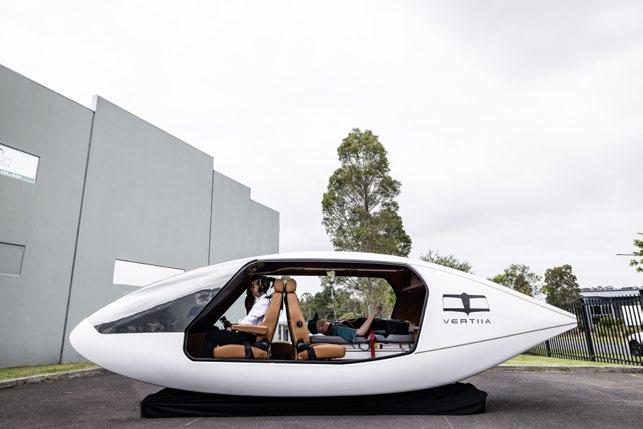

Having joined in 2007 and progressed to head up international development, can you tell us about growing up with Edra? Since I was a child, I was very aware that experiencing Edra from the inside was an honour. Every afternoon after school, I’d spend a few hours within the production facilities or in the offices. At the time, I saw it as an extraordinary world and I enjoyed it instinctively.
Did working for the family business happen organically?
The idea of joining the company had always fascinated me. At 16, I started thinking about it more seriously. I was nearly done with school, and I started thinking about what my future could be like. Then at 18, this idea materialised more prominently. I studied economics and then immediately started working at the company.

What was happening at Edra when you came aboard?
The company was in its 20th year. A few years earlier, in 2004, we presented On The Rocks, a sofa by Francesco Binfaré. For the first time, Binfaré had the idea of separating the seat from the back in a clean, precise way so the backrest could be moved freely. This project
involved a major investment by the company in terms of materials and a long development; we started working on it around 1997. For the first four years the sofa was difficult for people to understand, but around 2007 it started to generate more interest. People understood what the project really meant. And so, my early work focused on that: drawing people’s attention to this design.
Is it
to say your role to this day revolves around communicating the company to the world?
I have always focused on the storytelling surrounding Edra, on talking about our reality. We used to be called strange, extravagant, extraordinary, “for the few”. I didn’t understand this labelling for a company that is instead serious and precise.
We have always given great attention to creating long-lasting relationships. There are people in the company who have been with us for 35 years. And, of course, with the designers there is a relationship that, over time, has led us to extraordinary projects.
For Niccolò Mazzei, whose father Valerio founded the iconic Italian design furniture brand Edra in 1987, innovation rests as much in ageold manual techniques as in technology and the materially unexpected. – Interview by Rosa Bertoli
This is a family business, but more like an extended family, right?
It is a somewhat anomalous family business. The family component is important, but we strongly believe in empowering people. One must not [simply] feel part of Edra; one is part of Edra. It is important that each person is an active engine for development, for generating something new. And for this, the social factor is very important. Relationships with designers are crucial because they are the ones who bring us the ideas, the reflections, and the observations of daily life that we might sometimes not be able to see ourselves.
Your pool of designers and resulting collections are extremely varied. The company’s catalogue has only about 45 products, but every single one is completely unique and different from the rest. Who have been the key creative players for Edra?
There are many. The Campana brothers started their design career with us, with the Vermelha Chair, made with 500 metres of hand-knotted rope. We can only make one per week. It’s an artistic masterpiece;
there are only two people capable of doing it. It was thanks to projects like the flowers by Masanori Umeda from the '90s, or the designs by Zaha Hadid—whose first real, three-dimensional project was done in 1987 by Edra—that we are now able to work on complex designs from a scribble, to understand what an idea can be. Through all these treasured collaborative experiences, the company has managed to progress. These collaborations are like books; each page is necessary to move forward.
In addition to a great contemporary design heritage, Edra is also known for its unparalleled push towards innovation. Can you tell us about some of the key discoveries that have defined Edra products?
Despite our limited collection, we use a large amount of materials, from the most obviously spectacular, like Swarovski crystals, to ecological furs, synthetic raffia, and the polyurethanes that we use inside our sofas. Over the years, we have made improvements that have led to extraordinary results. The most important innovation has been the Gellyfoam polyurethane we patented. It is a mix of

materials derived from a polyurethane and a gelatin that come from the medical field. We debuted it with the On the Rocks sofa.
What’s the story behind the Gellyfoam?
Edra’s interest has always been to make people sit like [they’re on] a cloud, and this idea finally materialised with Gellyfoam. It all started from a chance meeting. One evening, a supplier who was visiting Edra got stuck here in a storm. We were killing time chatting, and he briefly mentioned this jelly that was used to make medical prostheses. We looked into it, and it seemed extraordinary to us, so we tried grafting it onto a polyurethane component to see what happened. We studied and developed the formula for years and arrived at this polyurethane with memory. It is not a [conventional] memory foam, which loses density over the years; after years of use the Gellyfoam always remains perfect. It compresses, compacts, squashes; you can sit on it hundreds of thousands of times, it always maintains the same density.

One thing that hasn’t been eliminated by innovation is that of handmaking. Every Edra product is still made by hand, correct?
Yes, everything at Edra is made by hand; we don’t use any industrial machinery to produce our furniture designs. We approach our work like a 17th-century Florentine workshop. Given our Tuscan origins, attention to certain traditions is a key influence. But it’s a complete mix. We are influenced by the medical sector, the aerospace sector. For example, when we use crystals, we apply them to a special high-strength fabric containing Kevlar [a synthetic fibre around five times stronger than steel]; it’s the only material we could find that resists time and wear.
Among Edra’s most distinctive designs are the polycarbonate pieces by Jacopo Foggini, including the A’Mare outdoor furniture collection that appears to be made of water. This collaboration seems a classic example of how Edra is a company of visionaries and the result of encounters with outside-the-box thinkers who are—dare we say—a bit crazy?
If somebody does something innovative within their sphere, they must be a little crazy! Jacopo’s extraordinary artistic ability to work with polycarbonate is truly special. He has the ability to work with an extremely modern material and make it classic with a very simple gesture. To work with 90 metres of hand-cast filament, in a world where there are more and more 3D printers, is a testament to our passion for making things by hand. If we were to lose our manual skills as a company, we wouldn’t have a future.
How would you describe Edra’s recipe for creative collaboration?
For us it was important to have started collaborations with people who hadn’t yet done something specific in our field. Thanks to this formula, each of them gave us a new point of view. That helped us to grow as a company.
In your opinion, is there a single piece that best represents Edra?

Perhaps above all, the Standard sofa (pictured) Aesthetically it may look like a normal sofa, but the most difficult thing to perfect for a sofa company is the sofa itself. Having created a sofa that adapts to the needs of those who use it is an exceptional thing. The difficulty was to build a single cushion that is part of the structure, a cushion that integrates all the qualities of living with a sofa. Thanks to the technology we have invented and collaboration with two leading engineering firms operating in the automotive sector, we reached an efficient mix of materials. After 40 years of use, the cushion mechanism will still be perfect. Creating this object that works dozens of times a day for 40 years and seeing that the result was flawless—these are the experiences that fascinate us.
How would you summarise Edra’s mission?
For a few years now, we have been using three words: comfort, elegance and performance. These values underpin the synthesis of the company; we constantly strive to achieve them. They are the starting point for thinking about design and beyond.

“In the past decade, consciousness around sustainable design has grown significantly. Our clients are typically well informed and come to us with a desire to incorporate sustainable design features in some capacity. They tend to be knowledgeable about solar panels, and water collection and storage, and expect them as standard features, in addition to an insulated, well performing building envelope. One of our key focuses is on reducing embodied carbon. To achieve this, we prioritise the use of locally sourced, high-quality materials such as masonry and stone, which have a low embodied energy and help to reduce the house’s carbon footprint.
One of our recent residential projects, The Limestone House in Toorak (pictured), benefited from a client with a passion for sustainability and an interest in high-quality design. The project used two international sustainability standards, Passivhaus and The Living Building Challenge, which have strict requirements. The Passivhaus principles were used to create a comfortable living environment with minimal energy use by producing a high performing building envelope; the thermal shell (walls, floor, and roof) was prefabricated to improve quality control, waste management, and time management during construction. The indoor air quality

is excellent too, thanks to the house’s 100 per cent fresh air mechanical ventilation system with heat recovery. The Living Building Challenge informed the choice of healthy, local materials and an off-grid approach to energy and water management, resulting in a house made from high quality materials with excellent sustainability credentials.
The recently completed Bass Coast Farmhouse in regional Victoria is also off-grid, with solar arrays on the roof of the agricultural shed and freestanding frames in the field. The house is located near a significant conservation reserve, and its orientation considers the land’s shape and seasonal weather patterns. The goal was to retain the open and uncluttered landscape along the wild, natural coastline. Water conservation was a primary consideration due to the threat of bushfires. Rainwater is harvested from the roof of the house and shed and used for all potable water needs as well as for the property’s hydronic floor heating during the winter months and is also stored for bushfire fighting.” wardle.studio
With architects continually unearthing new ways to simultaneously elevate aesthetics and environmental performance, we talk to three leaders in residential design about how they are integrating sustainable features into their work and what they see on the horizon for climateconscious design.
“Over the last few years, we have seen clients become increasingly conscious of sustainable opportunities—from energy efficiency and material selection to overall carbon impact. There are more requests for energy-efficient appliances, LED light fittings and solar panels, as well as for rainwater capture and reuse systems used in garden irrigation.
This trend for sustainability allows us to consider other design possibilities and suggest alternatives that are both better for the environment and able to improve a home’s liveability. Our studio has an established green library of sustainable materials, fixtures and finishes that we like to use. Across our offices in Tasmania, Victoria, South Australia and New South Wales, our designs must respond to different climates, each with its own environmental opportunities. We always aim to use locally sourced materials and products; work with local suppliers, manufacturers; and support local tradespeople. These choices also flow on to landscaping, such as selecting native plants suited to their climate.

We primarily begin each project with passive design principles in mind. Australians love the outdoors, so creating spaces using natural cross-ventilation and sun shading is easy to achieve, given that we design spaces for indoor-outdoor living. We are fortunate to have access to some great natural building materials. And while it may not be possible to adopt solely local materials, fixtures and fittings, we are certainly seeing our clients shift towards—and celebrate—locally crafted products; this includes materials like timber and other natural products with a low embodied carbon footprint.
Looking to the future, I think we will continue to see an increase in demand for energy-efficient designs that have the added benefit of enhancing health and wellbeing. Similarly, as natural disasters such as floods and bushfires become more commonplace, we will increasingly look to integrate design with a response to climate resilience.” cumulus.studio
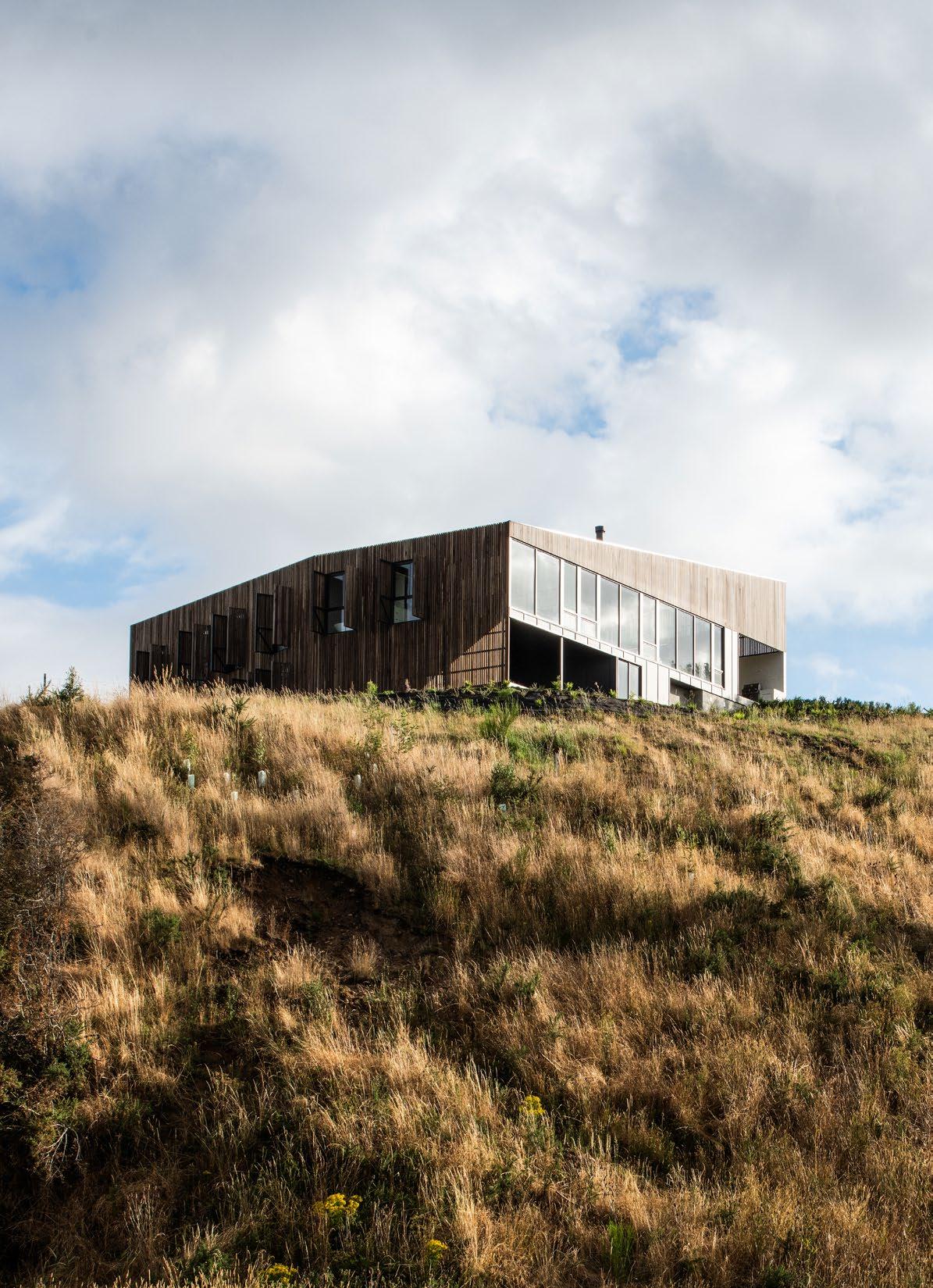
AT CHESHIRE ARCHITECTS, NEW ZEALAND

“Responsibly sustainable design is becoming less of an optional and more of an essential part of every project— no matter how big or small.
At Cheshire Architects, we have begun to see some of our early environmental aspirations realised. With our client Cooper & Company, we set out to create New Zealand’s first Green Star-accredited hotel, resulting in a long journey of discovery, experimentation, and innovation. On the façade, this project carefully balances solid mass with transparency; we turned away from traditional floor-to-ceiling glazing in favour of a “constellation” in brick and glass, significantly reducing the building’s
With its cosy wood fire, sweeping views and fragrant timber-lined walls, the living space of this award-winning off-grid Awaawaroa Bay residence on Waiheke Island celebrates the indoors and outdoors in equal measure.ongoing energy use. Sustainability and architectural intent are so entwined here that it’s often impossible to separate one from the other. Moments like these are where we start to see that our highest ambitions for architecture are not at odds with our fundamental ambitions for environmental resurrection.
On residential projects there might be an expressed desire to use solar power, increase planting and biodiversity, or carefully control sunlight and shade. But we often find that rather than pre-determining these outcomes, the best first step is to take a broader view of the whole project’s potential; this is when it gets really exciting, and we begin to create resilient architecture where sustainable thinking and decision-
making is an ingrained part of the design process. It really is in everything from bricks and mortar down to the teaspoons. For our studio, sustainability is not a burden on design but rather an opportunity for the curious designer. We see architecture at its most ambitious as a means of protecting and enhancing our environment, creating both fuel for innovation and new beacons of design that compromise neither aesthetic ambition nor the planet. In 2023, we aim to measure embodied carbon in all our projects and align ourselves with international targets for carbon reduction and net zero buildings. Every year we must challenge ourselves to be better than the last, to reach further— we’re up for that.”
cheshirearchitects.com
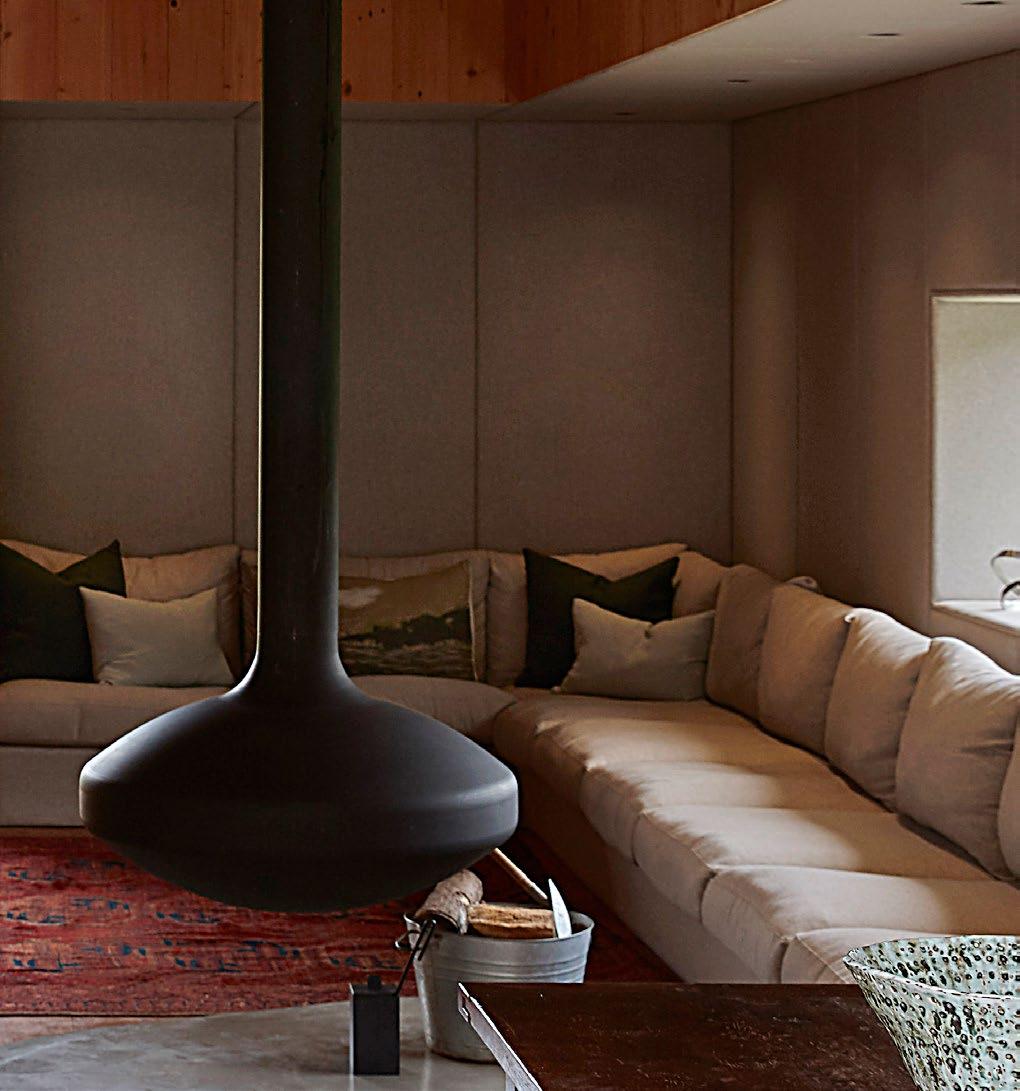
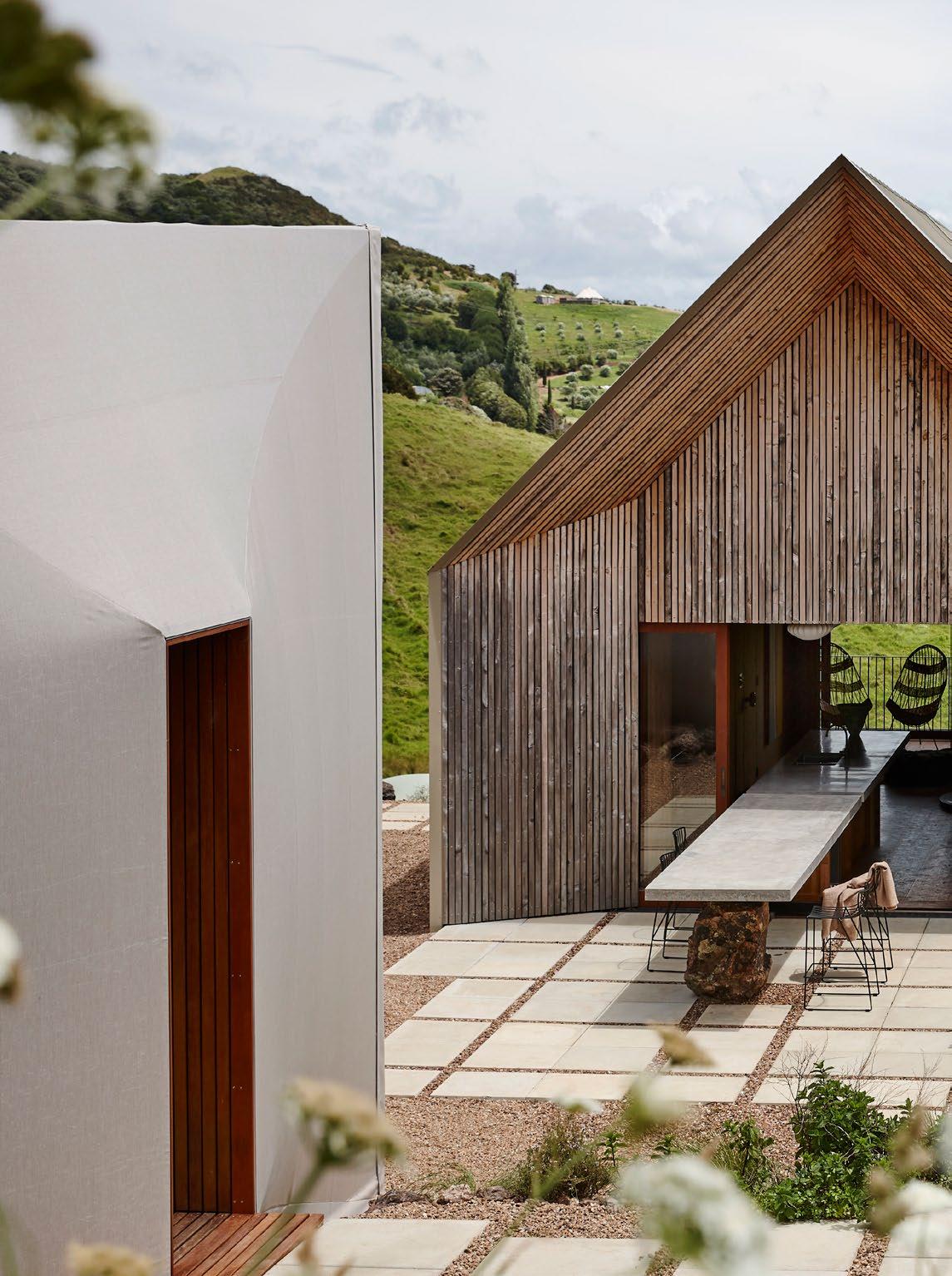 Two canvas-cloaked, timber-lined sleeping pavilions reminiscent of the yachts that frequent Awaawaroa Bay flank the main off-grid residence.
Two canvas-cloaked, timber-lined sleeping pavilions reminiscent of the yachts that frequent Awaawaroa Bay flank the main off-grid residence.
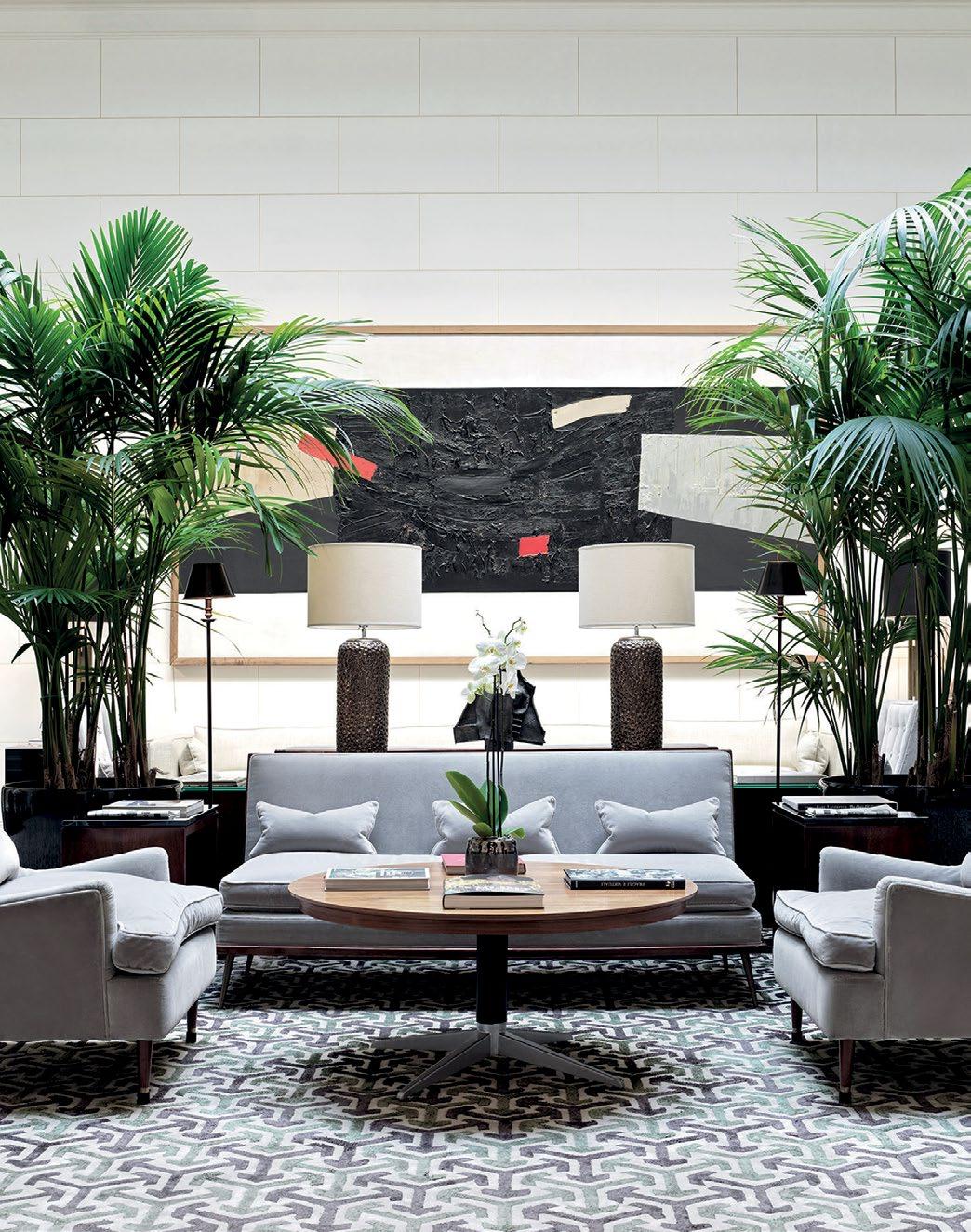

In formulating his vision for the future, Argentinian artist Tomás Saraceno looks to the past. Inspired by the synergies and understandings that humanity possessed thousands of years ago, when lives were more attuned to the cycles of nature, Saraceno’s work elucidates how traditions of harmonious living are more relevant than ever—despite their low profile in a fast, technologically driven world.
Saraceno’s broad range of work encompasses large-scale installations, real-world experimentation, activism and participation in international events such as last year’s COP26. He describes his central interest as being “dialogue with forms of life and life-forming,” which has seen ongoing artistic and even scientific inquiry into the phenomenon of flight, the lives of spiders and their webs, and the capacities of natural forces such as air, thermal rhythms and the sun.
Much of his artistic work and creative experimentation, conducted at his sizeable Berlin-based studio, has been in the pursuit of flight without fossil fuels. An ongoing interest in kiting (or ballooning) spiders—which create parachutes of gossamer silk to catch updrafts and drift through the jet stream to propel themselves between locations—is made manifest in his beautiful, often immersive large-scale installations of web-like structures. Such micro interests inform larger investigations.
Over more than 15 years, the artist has produced a series of prototypes for solar- and wind-powered balloon flight. The most high profile example is his work Aerocene Pacha, in which Saraceno successfully flew a fully solar-powered hot air balloon over
Argentina’s Salinas Grandes for 81 minutes, breaking numerous world records with the World Air Sports Federation for altitude, distance and duration of such a flight.
Saraceno’s curiosity is insatiable. He dares audiences to imagine a radically different future—yet there is nothing strident about his approach. We sit talking in the central hall of Brisbane’s Gallery of Modern Art (GOMA), beneath the floating canopy of giant air-filled spheres he has created for the institution’s major group exhibition, AIR. They drift with ease and elegance above us, gently bumping their mirrored surfaces as they circulate the space.
He is in Australia for this and another exhibition: Oceans of Air at MONA—his first Australian solo. Both are timely opportunities to consider the vitality of our shared atmosphere. His work Drift: A cosmic web of thermodynamic rhythms (2022) seeks to activate our awareness of the transformative potential of that atmosphere. “Air belongs to everyone,” says Saraceno, “and we need to get it back.”
Saraceno was born in San Miguel de Tucumán in northern Argentina, but his family fled the country during unrest in 1976, seeking asylum in Italy and returning home a decade later. He went on to study architecture in Buenos Aires, before moving to Frankfurt in 2001 to attend Städelschule, an experimental art academy. One of his earliest big breaks as an artist was his inclusion in the 2009 Venice Biennale, in which he created Galaxies Forming Along Filaments, Like Droplets along the Strands of a Spider’s Web, a series of impressive floor-to-ceiling webs made from black rope.
IN HIS FIRST AUSTRALIAN SOLO EXHIBITION, THE ARGENTINIAN ARTIST CONFRONTS THE EXISTENTIAL CHALLENGES FACING HUMANITY WITH BOLDNESS AND BEAUTY. – BY
In his life and work Saraceno (pictured right) is driven to make a difference, to advance knowledge, and to explore possibilities. He is preoccupied with the ecological degradation caused by climate change. “The world is falling apart,” he says. “All I can do is try.” He believes real change requires a shift from what he terms the “Capitolocene” (a dominant, exploitative model of carbon-driven capitalism, an “epoch of eco-suicide” in existence since 1945) to the “Aerocene”. The Aerocene vision—one he shares with other artists, researchers and scientists—removes hierarchies in favour of equality, participative actions, co-creation and collaborative practices.
The spheres above us at GOMA float thanks to their construction from two different lightweight materials that Saraceno and his team have developed, inspired by materials used in sustainable flight technologies. Their construction includes a mirrored section that deflects radiation from the sun while a second transparent area, designed to contain and maintain temperatures inside the sphere, allows floatation without fossil fuels, “powered only by the thermodynamics of the planet” Saraceno explains. These sculptures, the first of the artist’s indoor installations to echo the construction

of his aerosolar balloons, move in response to changes in air temperature caused by audience bodies as they enter the space.
I ask him if an understanding of physics informs his interest in flight. “Maybe physics and science could learn from the arts,” he says. “Sometimes we could learn together, maybe. The knowledge that is locked within certain forms of knowledge does not help to transcend the possibilities of that discipline. It’s going to be lost in their own world.”
This tendency to break down barriers, work with different philosophical paradigms and foster a growing community of likeminded practitioners and people is central to his work. “Slowly, [my work is] hopefully allowing more and more people to experience the ability to float with the rivers of the wind or from the bottom of the ocean of air, in a much safer relationship with the world.”
Indeed, part of GOMA’s AIR exhibition is a Saraceno flightstarter kit that theoretically allows individuals to launch their own aerosolar sculpture. The kit hangs on the wall, components attached to a silver mirrored cross, including sensors so that its pilot may add measurements of humidity, air pressure and other atmospheric
data to the Aerocene community’s collective climate action. This democratisation of the atmosphere is necessary, Saraceno says, because “the air is so often militarised and divided… we need to bridge this form of knowledge, to form these alliances.”

Such collaborations with the natural world are also central to Saraceno’s MONA exhibition. Oceans of Air calls for the acceleration of environmental action on earth, in its atmosphere and beyond. During previous visits to Lutruwita (Tasmania), Saraceno saw caves inhabited by spiders who emerge only at night, fuelling his long-held interest in spiders and spider webs. Extensive web installations are a key feature of the exhibition.
In a subterranean exhibition space, with dark rooms both spooky and fanciful, spiders and their light-as-air webs build on Saraceno’s ongoing international community research project, Arachnophilia. Here, intricate hybrid webs form “a material memory and diagram of the spider’s drift through the air” to become a poetic paean to old and new ways of living in the world.
Leaves from the fagus (Nothofagus gunnii), Tasmania’s only native deciduous tree, smoked by the Palawa people (local Traditional Owners), also feature in the exhibition, along with charts measuring air quality from all over the world; graphic illustrations of the demographic inequity in our collective atmospheres from Mumbai to Geelong. The charts challenge assumptions about the benign nature of air with the data translated as circles, shaded to describe air quality. As Saraceno relates, those most affected by climate change across the globe are also those who are least responsible for the extreme situation in which we find ourselves.
Such works are both arresting in their aesthetic finesse and urgent in their messaging. “I’m inspired by people who are living in a different way,” Saraceno explains. “I’m going to Argentina to meet again a community who, like many Aboriginal communities here in Australia, live in a very different way to how I’m living.” He wants to learn and draw from these different rhythms of life.
Art is rarely at the forefront of the debate about the way to achieve a better world, but Saraceno believes that beauty is required to inspire changes in attitudes. “We need to be seduced to allow ourselves urgency,” he says. His work revives the idea that the realm of artists extends beyond the studio or the gallery into the real world.
Air is central to shifting the regimes of inequity so entrenched in 21st-century societies. Oceans of Air, in its content and message, has the potential to promote a sense of shared responsibility.
As Saraceno notes, “not all have the right to breathe, and not all breathe the same air”—but we all should. In our journey toward new climate realities, visions like Saraceno’s may be crucial in inspiring— both metaphorically and literally—a necessary shift in the air.
Oceans of Air is showing at MONA until 23 July. mona/net.au/museum/exhibitions
 01. Soaring mirrored spheres from Saraceno's Aerocene project prompt visitors to think of themselves as tiny particles drifting through the air, sensitive to the motion of the universe.
01. Soaring mirrored spheres from Saraceno's Aerocene project prompt visitors to think of themselves as tiny particles drifting through the air, sensitive to the motion of the universe.

With close to 30 trips to Japan under his belt, acclaimed regional Victorian chef Michael Ryan has become Australia’s unofficial gastronomic envoy for the country that chefs cannot help but obsess over. With his little black book crammed with dining-out gems, from high-end to low-key, Ryan is just the guide to help plot a food-fixated Tokyo jaunt.

As owner-chef of the award-winning Provenance restaurant in north-eastern Victoria, Ryan—who studied chemistry before turning to food—has gained the respect of critics and peers alike for his elevation of Victorian produce and masterful command of flavour. Housed in a 19th-century former bank in Beechworth’s main street, Provenance has drawn consistent acclaim as one of Australia’s top regional dining destinations since opening in 2008, with Ryan’s reverence for Japanese cuisine increasingly evident in his menus over the years.
Adelaide-born Ryan first visited Japan in 1996, in his pre-chef days, and soon formed a twice-yearly habit of returning, driven by a hunger for a deeper understanding of Japanese cuisine and culture. “It drew me back. It just gets stuck in your head,” he says, recalling his second visit, 10 years later, which saw him drag wife Jeanette
and their then three-year-old daughter around to 24 restaurants in two weeks.
The now decades-long affair has led him to host food tours in Japan and even publish a book about Tokyo’s famed food culture. Co-authored with Tasmanian chef and photographer Luke Burgess, Ryan’s 2019 book Only in Tokyo: Two chefs, 24 hours, the ultimate food city charts the pair’s culinary adventures through the capital, sharing tales about the people and places that make Tokyo one of the world’s most perennially thrilling food destinations.
So what is it that makes Tokyo so compelling for chefs, in particular? For Ryan, it’s a combination of factors. “The incredible quality, variety and sheer density of great restaurants makes Tokyo exciting for anyone who loves food,” he explains, “but for chefs specifically, it’s that so many Tokyo restaurants look like the ultimate “chef” restaurant.” And by that he means a venue that is chef-run, with just a handful of seats, offering a small set menu. “For chefs, that kind of simplicity and singular focus is the dream,” he says.
Ryan’s travels have provided endless inspiration for his cooking—with each trip revealing “a new technique, a new dish, a new ingredient”— and for the way he approaches business. “The most important thing I have learned from Japan is to do things on my own terms,” he explains.
“The places I really love are the small, idiosyncratic venues run by people with a strong, independent, and often unique concept of what they want to offer. Sometimes this leads me to some very strange places.”
Eating out, Ryan has uncovered countless gems over the years, many of which he enjoys returning to, and says he is never lacking for new places to discover. Comprising a mix of classics and newcomers, this guide is designed to inspire culinary adventures for all moods and occasions—from traditional to envelope-pushing, glam to modest, morning to (late) night.
Chef and Japanophile Michael Ryan shares his guide to Tokyo’s best dining, drinking and cultural venues. – Interview by Leanne Clancey Photograph by Luke Burgess for Only in Tokyo (Hardie Grant Books, 2019)What’s the very first thing you like to do when you arrive in Tokyo?
Yakitori is usually one of the first meals I seek out, then I’ll head to one of my (many) favourite cocktail bars. I might start with all the sticks at Yakitori Toriyoshi in Naka-Meguro, followed by a Martinez at Bar Trench in Shibuya.
What should visitors know about dining out in Tokyo?
Restaurants work on their own terms far more in Japan. If what they’re offering doesn’t suit you, don’t ask for modifications, just find something else. The concept of saying “no” to a customer is very troubling for the Japanese.
Tokyo restaurants can be notoriously difficult to secure a table at. What's the secret?
There is no easy answer here, sadly. Perseverance and luck can certainly help, as can a good concierge at a top-tier hotel, but this is not always guaranteed. Plan ahead as much as you can but prepare yourself to miss out; you won’t get every booking you want but in a city like Tokyo there’s always another (equally great) option.
Any helpful etiquette tips when dining out?
Be on time. In fact, aim to be early, as finding places can often be problematic in Tokyo. Do an image search of the restaurant’s facade beforehand and screenshot it so that you have some idea of what to look for.
Favourite spots for breakfast?
Tokyo is a city slow to wake up so an Australian-style cafe breakfast is rare here, but a traditional Japanese breakfast is still my favourite. I recently stayed at newly renovated hotel The Okura and its Japanese breakfast is very good, served in a room that makes you feel like you are dining in the garden. Breakfast bookings are open to non-hotel guests too.
Somewhere low-key and traditional?
Most traditional-style restaurants will be open at lunchtime—think places that specialise in sushi, ramen, soba, udon and tempura. The Japanese have elevated crumbed pork to an art form, so I always seek out some good tonkatsu at lunchtime. Butagumi in Nishiazabu and Katsukura Shinjuku Takashimaya in Shinjuku are a couple of favourites.
How about for an elegant, multi-course dinner?
I love Florilège in Shibuya for its creative Japaneseaccented French cuisine and wonderfully theatrical dining experience; Den for the one of the most generous, fun and delicious meals in Tokyo; and Sezanne at the Four Seasons in Otemachi, where British chef Daniel Calvert’s precisely cooked, thoughtfully restrained dishes remind you just how good a set menu can be.
Best spots to immerse in Tokyo’s nightlife?
While I’m not a nightclub person, I am most definitely a bar person, and Tokyo has some of my favourite bars n the world. Memento Mori is a cocktail bar focusing on cacao, which might sound limiting, yet is anything but; some of the best cocktails of my recent trip were had at this bar. Bar Dice in Ginza gets my vote for a vintage negroni, made from Campari and vermouth that date back to the 1960s. Grandfather’s in Shibuya is another favourite; it’s smoky inside, the cocktails aren’t great, and the service can be surly, but it’s just so much fun— with excellent tunes too.
Favourite places to experience art and culture?
I love the Nezu Museum for its Asian antiquities and secret garden, which is a welcome retreat in the heart of the bustling Omotesando district. Any exhibitions at teamLab Planets [an immersive museum featuring works by international art collective teamLab that explore the intersection of art, science, tech and nature], are always a good choice. I do also love the Tokyo Metropolitan Teien Art Museum in Meguro, which is housed in a stunning 1933-built Art Deco mansion (a former imperial residence), surrounded by peaceful gardens.
Can you share something surprising about Tokyo?
It may seem incongruous, but Tokyo now has what must be the best pizza restaurants anywhere, run by chefs with a (typically Japanese) obsessive attention to detail and single-minded vision. My favourites include Pizza Studio Tamaki in Minato and Pizza Bar on the 38th, set on the 38th floor of the Mandarin Oriental hotel in Nihonbashi.
Any other tips for those on a foodie junket?
Tokyo is a big city, and while transport is excellent, it does take time to get from one area to the next. I always think it is best to explore your more immediate area, otherwise you’ll spend half your time commuting. If you take the time to look you will always find something nearby that may be just as good as that place you heard about on the other side of the city.
When not hosting Japan tours, Michael Ryan can be found at his award-winning Beechworth restaurant. epicurioustravel.com.au; theprovenance.com.au
Motoring enthusiasts are indulging their nostalgic instincts without compromising on modern comfort and capability with help from a growing number of restomod purveyors.
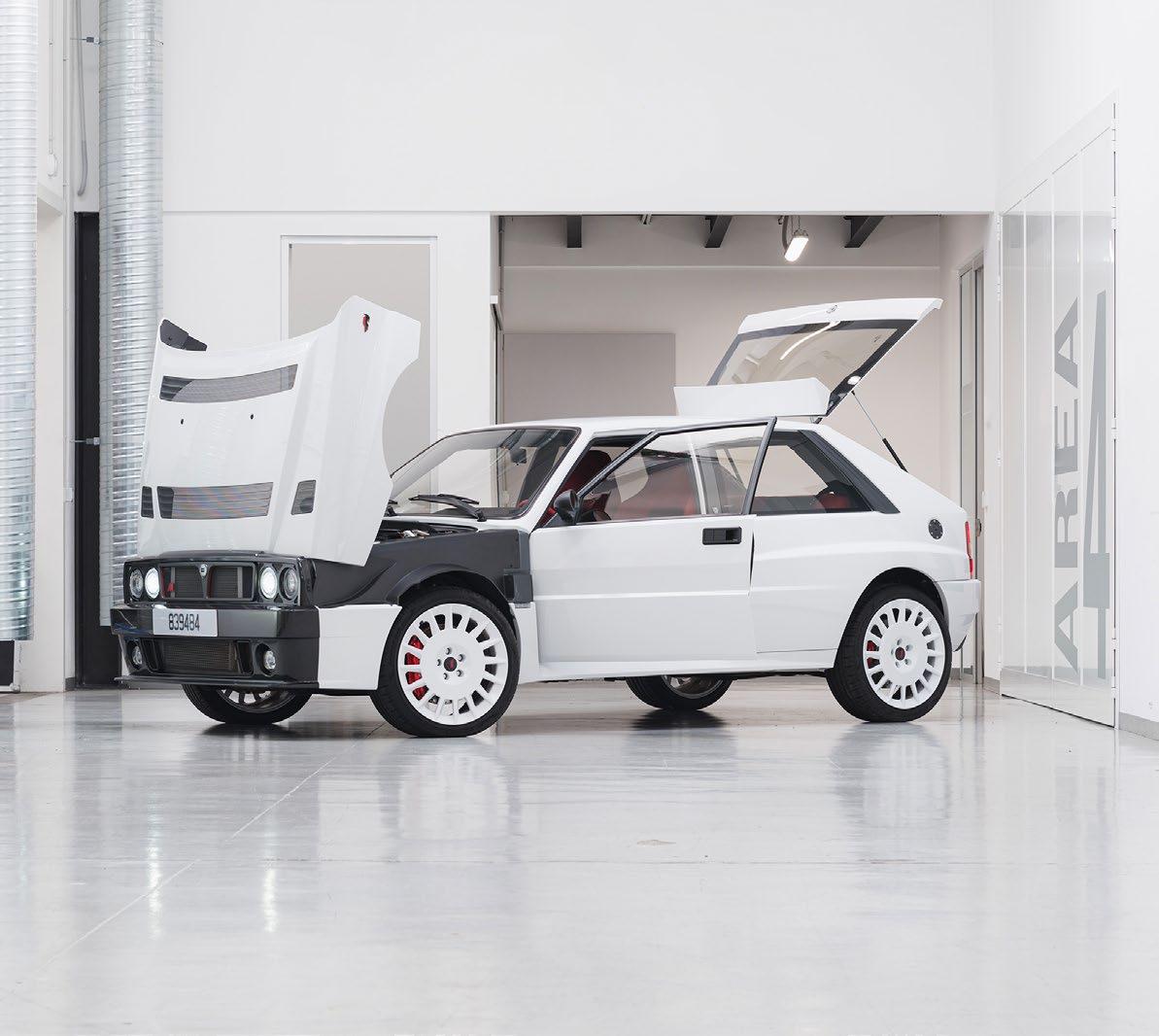 –
By Kyle Fortune
–
By Kyle Fortune
“Whenever you feel change, you develop a feeling for nostalgia, for what makes you feel good,” says car designer Carlo Borromeo. “You have the monumental change from the analogue car to the digital and from combustion cars to the electric ones. With all these big transitions, there’s an interesting change in dynamic.”
Borromeo, along with friend and business partner Eugenio Amos, is behind Automobili Amos, an all-Italian company that builds the Lancia Delta Integrale Futurista. Featuring a two-door, carbon fibre body and produced in a batch of just 20, the Futurista is Automobili Amos’s evolved take on the Delta Integrale. It uses an original car as its basis but applies modern design, manufacturing and materials “under its skin” to unleash fresh potential for the current era.
Automobili Amos isn’t alone in creating such a car. If there’s been a notable trend in the classic car world in the past decade it has been the rise of the “restomod”, where classic cars are restored, enhanced and modified to deliver a superior driving experience.
“[The approach] works well with cars of the late '80s and early '90s,” Borromoeo notes. “It’s like with music [of that time], that was an era of great creativity but of poor production. [Similarly], the cars had a lot of personality, but also very evident flaws in the way they were built. That makes these cars prime candidates for restomods because what you do with a restomod is take the identity
of a car and carve away all the bullshit and let it shine. You take it to its maximum expression.”
As long as cars have been restored there has been a degree of enhancement, but today the restomod is a recognised paradigm in the classic automotive community, and a growing one. LA company Singer, which has long worked with the Porsche 911, has arguably been instrumental in legitimising and popularising the idea of such re-imagined cars outside the traditional boundaries of the automotive enthusiast community. Since 2021, Australians have enjoyed more streamlined access to these luxury vehicles via Victoria-based importer Zagame Automotive.
A number of other companies have made their names with tricked-out tributes to Porsche classics: Gunther Werks, Canepa and Emory Motorsports in the US, Tuthill and Theon Design in the UK, Nardone in France to name just a few. For those with a taste for off-road adventures, Icon in California’s San Fernando Valley is the go-to for a Ford Bronco or Toyota FJ modelled on the 1960s originals, while Land Rover enthusiasts can choose from any number of specialists to build a better performing vintage-look 4x4.
For a high-performance, modern take on a muscle car with improved braking, better handling, and superior comfort and looks, look to US outfits such as Ring Brothers, Foose Design or Pure Vision.

UK-based Moto Technique will enhance your vintage Ferrari, while Eagle E-Types opens up Jaguar possibilities; Mechatronik in Germany will make the Mercedes-Benz of your classiccar dreams; Cyan Racing in Sweden has the Volvo P1800 covered; and Kimera in Italy offers a glorious take on the Lancia 037.
UK-based Alfaholics, run by respected Alfa Romeo specialists Richard, Max and Andrew Banks (father and sons), is focused on the 105 series Alfa Romeos. Max—the company’s director of sales and product development when he’s not busy racing— describes it as a mail-order parts company. While that’s technically correct, it undersells the family-run business somewhat. “Our business has evolved over four decades of racing, restoring and improving parts for Alfa Romeos,” he explains. “I grew up around these cars.” The result is that Alfaholics is not only able to sell you parts for your car but also build you a significantly enhanced GTA-R coupe according to your particular specifications. Banks adds: “We keep the DNA of the species but optimise it to be the best of what it can be.”

Naturally, with all restomod cars, the process takes time and money. Hours count in the thousands, and the materials and bespoke nature of each build means costs can vary widely. Prices start at around AU$450,000, rising to more than $2 million. Even so, the best restomod companies are all backlogged with orders. Automobili Amos sold every one of its 20 Futuristas within a month of its reveal.

Compared to modern super and hyper cars, restomods are actually relatively inexpensive, particularly when you take into account the exclusivity and opportunity for personalisation they allow. They’re arguably more enjoyable and engaging to drive too, the restomod phenomenon itself being somewhat of a backlash against the tendency for everfaster but significantly less-involving drives in the contemporary performance car sphere.
Like Carlo Borromeo, Simon Lord of British restomod company Redux also circles back to nostalgia as the driving force behind the trend. “People remember these cars as kids, maybe their neighbour, their dad, mum, uncle or friend had one and they always lusted after one but could never really afford it. Now they can afford it, and they drive one and it’s underwhelming, because why wouldn’t it be? Things have moved on significantly since the original car was introduced. Therefore, the question is: how do I keep
the look and feel of that thing that reminds me of that emotional attachment to that time of my life but drives like a modern car?”
Redux focuses on the BMW E30 M3. Lord explains that he wants to simplify and improve the car; his goal is to create a run of 30 cars with performance akin to the more modern E46 M3 CSL. That’s achieved by applying lighter weight materials, with a body almost entirely constructed from carbon fibre—a car respectful to its era but enhanced in every way.

Interestingly, the restomod is enabled by the same modern production techniques that have, in many ways, homogenised the automotive world in the first place, including things like rapid prototyping and 3D printing technology. The fact that companies can produce limited batch runs of unique parts, often in single digits, rather than in runs of hundreds or thousands, is enormously beneficial for this kind of bespoke production.
While it’s no surprise that demand is high for such expressive and engaging machines, it currently falls to only a few dedicated souls to breathe fresh life into these museum-quality automobiles.
 01. British company Redux enhances the BMW E30 M3.
01. British company Redux enhances the BMW E30 M3.
Words
JANE ALBERT
Photography BEC PARSONS

Styling
JANA BARTOLO
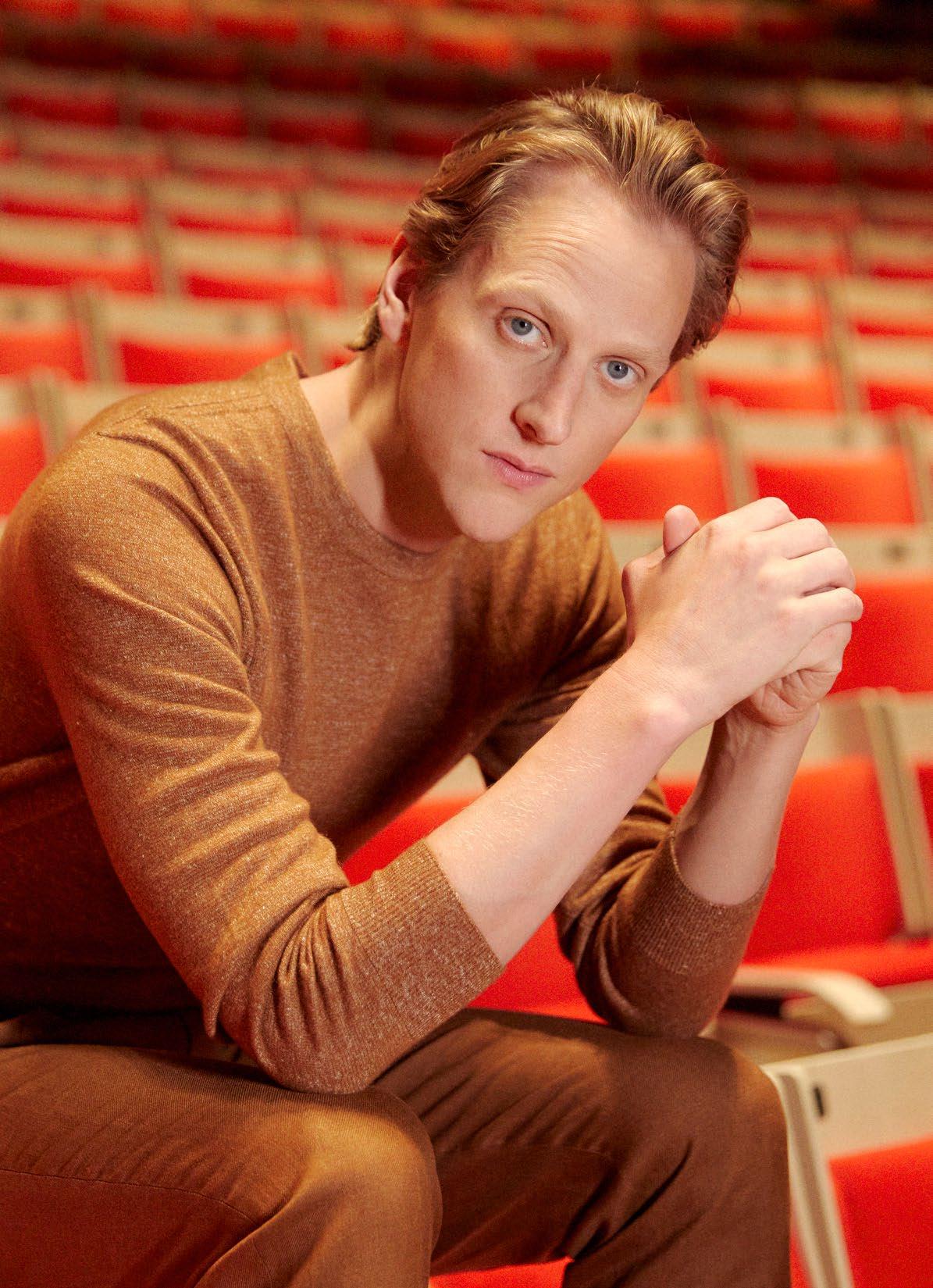
Formerly the American star of the international ballet world, David Hallberg may have left the stage to become the artistic director of The Australian Ballet but as the institution celebrates its 60th year on stage, he’s ready to lead.

There was a time when David Hallberg loved the spotlight. The American star of the international ballet world was for many years in demand from Europe to America, performing with stellar companies including American Ballet Theatre, the Bolshoi Ballet and the Royal Ballet in London.
“When you’re a dancer, it’s all about you. It’s about your performance that night, how your body feels, how you fuel your body—you’re the one in the spotlight,” Hallberg says.
Now all that has changed. But while Hallberg may have retired from his career as a professional dancer, he is instead the one responsible for training the spotlight on an entire company as the eighth artistic director of The Australian Ballet. Having taken the helm in 2021, it is Hallberg’s vision that audiences will see rolled out across the nation’s stages this year; the 60th anniversary year for the 75-strong company of dancers. And Hallberg couldn’t be happier.

“The year is big, but it’s also a year I know audiences are ready for, and dancers are ready for,” he says. “My goal is to make The Australian Ballet as relevant as possible to today, relevant to audiences, relevant repertoire, so when the curtain goes up you see a living, breathing artform. And it’s the beauty and history of this artform that I really believe in and want to uphold.”

Whether you lean towards the more traditional, classical end of the spectrum or the edgier contemporary works, there is plenty on the program, from revitalised productions of Swan Lake and Don Quixote to George Balanchine’s fiendishly exacting, globally sought-after work Jewels. There are two world premieres from two of the freshest young choreographic voices working in Australia today: The Australian Ballet resident choreographer Alice Topp and Australian Dance Theatre artistic director Daniel Riley.
It is all part of the Hallberg vision which, after two years in a Covid-interrupted world, he is finally having a chance to unveil; one that honours an artform with deep historical roots while ensuring its continued relevance in our evolving society.
The country’s second-oldest classical ballet company (West Australian Ballet was founded in 1952), The Australian Ballet began in 1962 under the guidance of former dancer and ballet mistress Peggy van Praagh. It featured founding members who would later become some of the nation’s best dancers, Marilyn Jones, Garth Welch and Kathleen Gorham among them.
Hallberg has his own profound history with the company. He quietly relocated to Australia in 2015 to rehabilitate with its world-leading medical team, after suffering career-threatening complications from an ankle injury. Hallberg spent 14 months in Melbourne rehabbing with the company’s internationally respected physiotherapist Dr Sue Mayes, who ultimately helped save his career. In return, Hallberg became the company’s first resident guest artist in 2017 and committed to return to Australia to perform with them annually, gaining a great understanding of and friendship with The Australian Ballet in the process.
Zegna Chore Trousers www.zegna.com
Replacing former company dancer-turned-artistic director David McAllister, who stepped down in 2020 after two decades, Hallberg says he was brought in to capitalise on his international experience and contacts and to “sharpen things up”. “That doesn’t mean I’m going to completely dump everything and start all over again [but] be conscious of the balance,” the 40-yearold says. “Some people may think ‘Swan Lake again?’ and want a new creation, whereas others come to the ballet because they know they’re going to get a beautiful production of Swan Lake. It’s really important to balance the two and not veer too far in one direction.”
Working with a new executive team—British conductor and music director Jonathan Lo succeeds Nicolette Fraillon and former Bangarra Dance Theatre executive director Lissa Twomey has taken over from Libby Christie—Hallberg is excited to unveil his vision for the company’s diamond anniversary. “It’s meant to invigorate, it’s meant to challenge, but it’s also meant to bring enjoyment,” he says.
Determined to highlight The Australian Ballet’s strength in the classical “ballet” of its title, Hallberg hopes to honour the company’s rich history by reviving two of its signature works, Swan Lake and Rudolf Nureyev’s Don Quixote. Hallberg firmly believes every ballet company needs its own production of Swan Lake, and while The Australian Ballet enjoyed huge success with Graeme Murphy’s 2002 contemporary take on the 1877 work, Hallberg sought out a more traditional production. “It’s the most famous ballet ever created and one that is still so valid in the classical repertoire,” he notes. He was delighted to discover in the archives the company’s own 1977 production, choreographed by Anne Woolliams and performed for 25 years, and will direct an updated production of Woolliams’ show featuring all new sets and costumes.
“Another thing that’s really important to me is that the repertoire doesn’t look like a museum piece, that we don’t date ourselves by just turning on the stage lights and bringing in a production that looks like a museum,” he says. The sizeable cost of the exquisite new design has been met through the generosity of no less than 800 donors following a targeted fundraising campaign.
It is in his determination to ensure classic works carry a fresh appeal that Hallberg is also reviving Don Quixote, a ballet developed for the stage but immortalised on screen in 1972 with The Australian Ballet by iconic dancer Rudolf Nureyev and director Sir Robert Helpmann. Filmed in a hangar at Essendon Airport, it became an international hit for the company. Hallberg will restage the original choreography but incorporate updated scenic design of the film’s set, including an on-stage screen.
“Rudolf Nureyev was one of the greatest dancers ever and created this film with the company that was so textured and full and busy and made audiences feel like they were in a plaza in Seville,” says Hallberg. “We’re replicating what was done and again, it’s [my duty] to ensure these productions aren’t museum pieces so when the curtain goes up we feel like we’re in Spain. That’s what makes the artform come alive.”
It is a sign of Hallberg’s international reputation that he was able to secure the carefully controlled rights to Jewels, choreographed by modern ballet master George Balanchine on the New York City Ballet in 1967. Requiring unwavering classical precision, Jewels is a notoriously difficult, widely acclaimed and opulently staged work, a threeact ballet created around the motifs of emeralds, rubies and diamonds. “Only the major companies around the world dance Jewels because of the sheer numbers the cast needs but also because of the technical difficulties of the choreography, the stylistic difficulties of the choreography,” Hallberg explains. “But I’ve just seen the first rehearsals and the dancers are so primed, they’re so ready and they’re so excited to dance the repertoire.”
Two other modern classics, Frederick Ashton’s The Dream and Marguerite and Armand will be performed as a double bill in Sydney, while The Tokyo Ballet will tour its Giselle to Melbourne.
From modern classics to contemporary ballets that have yet to be unveiled, Hallberg is particularly excited by Identity. A double bill, the commission sees resident choreographer Alice Topp and First Nations choreographer and artistic director Daniel Riley explore the concept of Australian identity. “One of my visions for the company before I even came in was that we have this platform. We’re the biggest dance company in the country and we have a huge responsibility to give opportunities to artists, to commission artists, not just choreographers, and to let them express their voice,” Hallberg says.
Topp’s work Paragon explores the identity of the company and its history by inviting beloved former dancers from various generations including Fiona Tonkin, Steven Heathcote, Marilyn Rowe, David McAllister, Madeleine Eastoe, Kirsty Martin, Lucinda Dunn, Paul Knobloch and others to join the current company in the new work.
Riley’s work, The Hum, looks at the relationship between audiences, performers and musicians and will be a collaboration with his company, Adelaidebased Australian Dance Theatre. A Wiradjuri man, Riley will collaborate with Yorta Yorta composer Deborah Cheetham and Taungurung designer Annette Sax, who will create new costumes.
This is only the second time The Australian Ballet will have collaborated with Indigenous creatives, after its landmark co-production with Bangarra Dance Theatre on Rites, which premiered in 1997. It is an important relationship Hallberg says he will nurture. “I’m a totally clean slate in Australia and I’m taking the temperature of what’s
needed in the ballet world and in this company, what voices need to be represented,” he says. “It’s no accident we’re having proper and meaningful First Nations collaborations with Dan Riley and Deborah Cheetham, and that’s going to continue. This isn’t just a one-off.”
In its 60 years the company has evolved into a truer representation of multicultural Australia, with dancers hailing from Japan, China, New Zealand, England, South Africa, the US and Russia. Having worked with multiple international dance companies and cultures, Hallberg believes The Australian Ballet truly represents an Australian style of ballet. “It doesn’t inhabit the stylistic qualities of the Mariinsky or the Bolshoi or the Paris Opera Ballet, because we’re not 275 years old, and that’s fine,” he says. “The Australian Ballet has a really modern view on what ballet is today, because it doesn’t have the weight of history. So what the dancers and the company offer is human-ness, [they’re not] untouchable, ethereal artists from another planet, there’s an Australian quality, a culture of openness and warmth.”
Two years into the role, Hallberg says he feels he is only just getting started. “We cancelled almost our entire season in 2021 [because of Covid], we only did 63 performances of a planned 159. But... silver linings, I got to look inside, look at the company, work with the dancers. So when we were at full capacity of performances last year, with soldout shows of Romeo and Juliet, I could feel how the machine ticks. We’re all match-fit—the dancers of course—but as a director I feel so empowered by the vision and energy of this company.”
With Covid also playing havoc with every last one of Hallberg’s planned international farewell performances in 2020 (select audiences were lucky enough to catch him in Kunstkamer in Melbourne and Sydney last year), you would understand if there was an air of regret around his retirement. In fact, the opposite is true.
“When you stop performing it’s not about you anymore. I am sitting in the [driver’s] seat and it feels quite selfless, like a custodian, a father, a curator, a counsellor at times,” he says with a laugh. “I don’t miss the spotlight. I’m so happy to be watching these dancers, seeing how the repertoire helps them realise their potential even more; hearing audiences loved this or hated that. This is where I should be right now.”
australianballet.com.au

Has acute lack of supply cast a safety net around the top end of the real estate market for the foreseeable future?
Here, three experts offer their take on the economic, cultural and psychological factors influencing the availability and pricing of Australia’s rarest residences.
— By Kirsten CrazeDespite the cooling climate across Australia’s mainstream residential market, the luxury segment is setting its own temperature. While there are several reasons why the top end performs at its own pace, the extremely tight supply of ultraexclusive property is a key driver.
Local luxury real estate volumes simply cannot keep up with the extraordinary demand from discerning buyers who want the best of the best—and have the funds to acquire it. In fact, Australia’s population of ultra-high net worth individuals (UHNWIs) grew by 10.1 per cent in 2021 to 20,874 people, according to Knight Frank’s Australian Prime Residential Review for Q4 2022.
The headcount of Australian residents with a personal net worth of more than US$30m (A$43m) is forecast to grow by a further 30.9 per cent over the next five years, per the Knight Frank Wealthy Sizing Model.
Though capital growth for prime property (considered the top 5 per cent of residential prices), fell by 1.2 per cent in the third quarter of 2022, it was still up 6 per cent year on year. So, while real estate values across the board are recalibrating post-pandemic, the severe undersupply at the pointy end of the market is set to keep prices buoyant. In Melbourne, sales volumes decreased in the September quarter by 36.1 per cent to just 156 luxury properties, while in Sydney that figure trended down by 26 per cent to 705 homes.
Offering some insight into the current market drivers, Mark Browning, head of Property Service Group at NAB, says that Australia’s luxury property market runs its own race because it is not impacted by the same external economic factors as general real estate. “It’s really an independent market and is more influenced by executive salaries, share
markets and other types of investment classes that don’t tend to influence mainstream property,” he explains. “And ultra-high net worth individuals are typically not leveraged—or at least not particularly highly leveraged—if they’re buying these types of trophy homes.”
He continues: “Because it’s such a different market, it has proven stronger than the wider property market over the last few months, particularly with offshore interest returning. Combine that with the scarcity of quality listings and it all adds to pricing pressure in that space.”
While interest rate rises have had a direct correlation with falling prices throughout the broader residential scene, Browning says the actions of the RBA are less likely to drive negative sentiment in the upper echelon.
“It would create more of an effect if interest rates were to impact the earning capacity of these buyers; if the companies they are leading or their investments were impacted heavily by interest rate movements,” he suggests. “If the share market takes a massive hit, for example, then you could arguably see some softening in luxury property prices.”
Another trait unique to the luxury market is the imbalance in the transaction process, says Kay & Burton managing director Ross Savas. Essentially, when UHNWIs buy a property, it is not a given that they will be letting another property go at the same time.
“Years ago, we’d sell a house and those buyers would list their home, so another property would enter the market. Vendors might change to smaller land or a bigger home but they were still moving around in the top end. Today we’re getting expats and overseas buyers coming in with nothing to sell,


or those who might be buying multiple homes for multiple generations of their families. The result is there’s no longer the stock to replenish that section of the market, which only adds to the scarcity, competition and exclusivity,” Savas explains.
The typical reasons behind buying and selling might keep supply rolling along in the wider property market, but the same incentives are often missing at the top. When the average Australian wants to upsize, downsize, or make a sea or tree change, they simultaneously become a motivated seller. When it comes to wealthier homeowners, there is no motivation to let go.
Savas adds: “They don’t want to sell, they don’t need to sell, so they don’t. People choose to sell, and that’s why there’s always a limited supply of these trophy properties, especially in Melbourne.” In this context, he says, no offer is too good to refuse. “I have seen clients offered 25 per cent more than their property is worth by buyers willing to pay big money, but these owners still don’t want to sell. They love their homes too much; they’ve had birthdays and weddings there and are not willing to give up those memories—for any sum.”
In his experience, two common themes drive most prime property transitions today; “Every buyer is different but most want the same two things: quality and location. This means ease of living and being surrounded by great amenity like restaurants, parks and sought-after schools.” He says today’s buyers also want the finished product so they can move straight in. “It’s not just because building costs have gone through the roof, it’s more about time—the time it takes to get plans approved, the time it takes to get the right team together,” he explains. “Sourcing a good plumber, electrician or architect is currently like finding hen’s teeth; they’re all booked up for 12 months or longer.”
Finding a move-in-ready residence is especially important for regional buyers, according to Liz Jensen, director of Kay & Burton Portsea, as the trade shortage can be more of a challenge outside the cities.
“These buyers want the property perfectly presented in every way,” she says. “They don’t want to be renovating or making decisions about tiles and carpets; they will wait for the property that’s ready to move into on settlement day.”
If metropolitan Melbourne has tight supply in the top end, then regional Victoria’s prize homes are even more scarce since the pandemic-induced flight to the country.
“The hunt for the perfect country house can be very limited because there just aren’t many and they don’t come up very often,” Jensen explains. “And when they do come up, sometimes they’ve been held by the same family for years, so may not be particularly well finished or turnkey-ready.”
Jensen's team has been busy assisting the increased number of buyers who turned their attentions to the Mornington Peninsula during the pandemic because of limits on international travel and a desire to have a permanent place for regular family getaways.
“During this period, wealthy homeowners in Melbourne discovered just how important family is. After spending more quality time with their kids and grandkids, the idea of a luxury home by the beach became very attractive,” she explains. “The peninsula is famed for its prestige properties, but at the maximum buying level we’re lucky to see one every year or two. There really does seem to be fewer on offer now than in previous decades because the buyers of today are accumulating wealth faster and therefore able to hold property longer.”


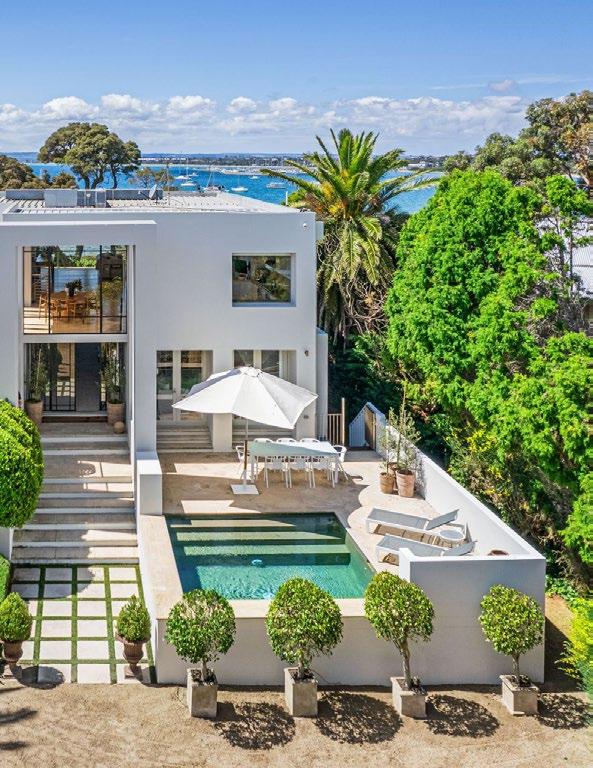
The promise of social media was always community. From the early days of platforms like MySpace and Friendster, the goal and the purpose was to bring us together. Influence, inspiration and commerce came later.
Over the past decade, as people became users (and then creators or influencers), the “us” became blurrier and the original raison d’etre slowly ebbed away. Growth—of both users and profit—became the goal, and algorithms increasingly dictated what and who we experienced online. As a result, that promise of unity and connection has come to feel more like a tease— or even a bald-faced lie perpetuated for profit.
WeAre8, a mobile-first social media platform launched in Australia last September, is on a mission
to change all that, promising to bring us closer to the people and causes we actually care about. And they will pay us for the privilege.
“How do we reimagine social in a way that’s free from algorithms, free from hate, full of love, full of community?” This is the question WeAre8 founder Sue Fennessy and her team asked while plotting their new approach to social networking.
She says WeAre8— which claims “The People’s Platform” as a subtitle—has arrived at a purposeful and progressive alternative model. The B Corp-certified company aims to divert $120bn in advertising profits away from tech giants and towards users, environmental causes and professional creators; this being the total dollar amount that brands are estimated to have
With new social media platform WeAre8, founder and chief executive Sue Fennessy wants to redirect billions in global advertising spend to people and planet—and create a user experience that emphasises community and creativity in the process.
spent on Facebook advertising in 2021. They will do this by harnessing “the infinite power we have as a community,” Fennessy suggests. The “8” in the platform’s name both evokes the infinity symbol and references the eight areas of impact in which the diverted funds are spent: climate change, food, health, education, equality, water, peace, and animal welfare.
“Social media is the medium of our time, right? But it hasn’t evolved to a place that serves the people,” Fennessy says. “I became really obsessed with reinventing the ad model to get that money back into the hands of people. After doing that, how do we then reimagine social in a way that has zero tolerance for hate and no anonymity? They’re the two threads we’ve spent the past seven years and $35m building.”
Photography AMIE MILNE
Born and raised in Melbourne, Fennessy moved to New York in 2009 and founded data aggregator Standard Media Index (SMI). By then, she had spent 20 years leading global sponsorship agency MM Communications and digital entertainment company Frontiers Group. Technology has been driving her work and thinking for decades, and it was in her role as chief executive of SMI that she got a front-row seat to the relationship between technology corporations and advertisers.
In her time there, she watched as the portion of the US$500bn annual global advertising spend that once bolstered local news, radio and television—constructs she believes “hold communities together”—shrank dramatically. Meanwhile, funds ploughed into Facebook, which in her view “didn’t share anything with people”, grew exponentially.
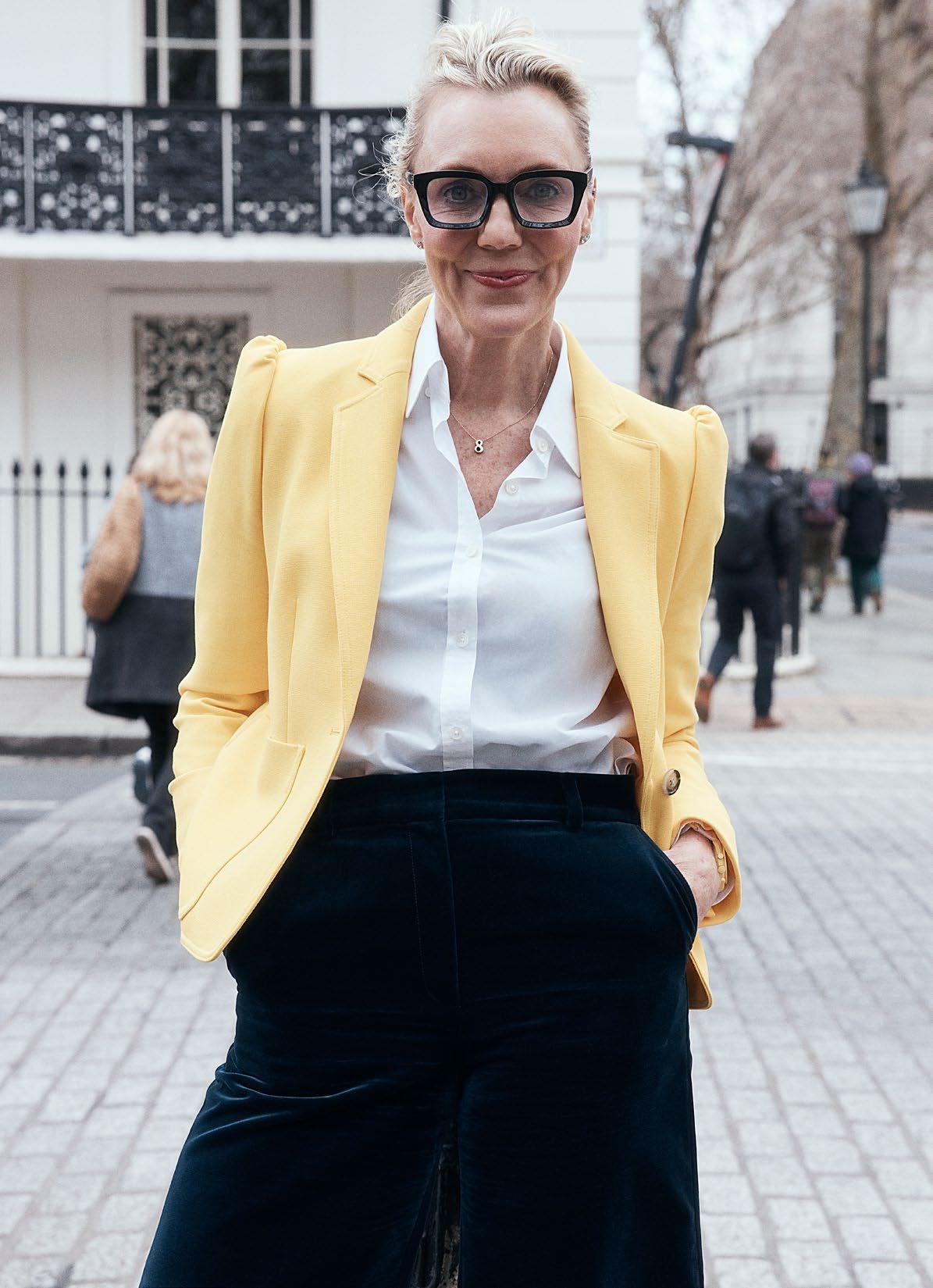
“I was in the US when the Federal Reserve came out with a statistic that 40 per cent of all Americans cannot find $400 in an emergency,” she recounts from her office in London, where she now lives and works. That was a catalysing moment. “I realised … each of us, in the US and Australia, is worth about $400 a year to Facebook alone. We’re in this shocking economic crisis, yet we’re being stripped of value.” Fennessy says social media users have quietly become an enormous unpaid workforce; they are generating the content that captures the audience attention which earns these platforms their advertising dollars. “When you see that injustice, you can’t unsee it,” she notes.

When advertisers buy placements on WeAre8, four per cent of their budget automatically goes to a charitable cause (they can choose from one curated by WeAre8 or select one of their own to support). A further one per cent goes to climate projects and five per cent toward carbon offsets.
The system also supports original content ideas, funnelling another five per cent of that advertising spend to a creator fund to reward artistic expression. This unseats the norm on other platforms where influencers receive money from brands or agencies to promote a product in ads thinly veiled as creative content.
As for general users—or “citizens” as they are called at WeAre8—those who watch two minutes of ads per day are also paid for their attention. It’s an appealing proposition both for users and for brands that value a captive audience. These micropayments, which users can choose to keep or pass along to charities, are derived from another 50 per cent of every ad buy. In a different kind of reminder that attention is a valuable resource, WeAre8 also sends citizens an alert to get off the app after using it for eight minutes.
Despite its promise, it might take time for people to buy what WeAre8 is selling. We are so accustomed to donating our time, content, data, behaviour and activity to platforms that getting something in return invites scepticism. “We have come to understand that as the norm,” Fennessy says. “The thought of getting something in return for the same behaviour is hard to compute, I think, when you first hear it.”
No doubt the current state of social media—marked by Twitter’s high-profile chaos and speculation about Meta’s decline—is opportunistic. An article published by New York Magazine in January about Elon Musk’s influence on Twitter pointed out that it was only a decade ago that Twitter was inspiring “utopian visions of how social networks could promote democracy and human rights around the world”. Now we are talking about the cultural and economic freefall of these big social media players.
With advertisers hitting pause on Twitter en masse, the platform’s daily revenue is reported to have plummeted 40 per cent from January 2022 figures. Meanwhile, mass layoffs across Meta’s various products—which include Facebook and Instagram—were headline news at the end of 2022, and the company began 2023 with a AU$600m (€390m) fine in the European Union for violating the region’s privacy policies.
TikTok also has its problems. Last year it was widely reported that nearly 40 per cent of Gen Z users were turning to TikTok over Google as a search engine at the same time that a research report by internet trust and safety body NewsGuard found that almost 20 per cent of videos it offered up contained misinformation. More recently, US Congress banned TikTok from being installed on federal devices due to security concerns that the Chinese government could leverage its parent company to access those devices. More than 30 states and a number of public universities also implemented bans, calling into question the app’s future in the largest social media ad market in the world.
For those of us concerned with what social media is doing to our communities, our democracy, and our brains, it often feels like we only have two options: either participate with mounting denial and disdain, or completely abstain. Alternatives have sprung up over time but in terms of media investment, none have actually posed any serious disruption
of the social model itself. If successful, WeAre8 will be the first platform that says we needn’t sacrifice our moral values to use social media while reminding us of our dollar value as users.
To that end, Fennessy is clear-eyed on her mission. After running the numbers, it’s hard not to be. “There are 21 million social media users in Australia alone,” she says. “If 20 million people in Australia joined WeAre8 and watched just two minutes of ads a day, in one month that would be $360m back to people, $7m to climate solutions, $3m to a creator fund, and $28m to charity. Every month.”
When WeAre8 was introduced in this country late last year, with former Nine executive Lizzie Young at the helm, The Australian Financial Review reported it was on track to hit 8 million users in the UK by the end of the 2023 financial year, with a goal to reach 100 million users worldwide at the same time. So far, WeAre8 has attracted commercial partners such as Suncorp, SBS, Coles and Telstra, with high profile figures such as sportsman Adam Goodes, journalist Sarah Wilson and performer Tsehay Hawkins joining as “changemakers” or advocates for broader uptake of the app.
Beyond this, Fennessy measures WeAre8’s success against a bigger, human picture. She explains: “That includes ‘How many meals did we get to people in need? How many people did we get access to fresh water? How many animals did we support? What impact did we have on the climate?’ Collective impact is really massive for me.”
She adds that she used to be furious about what the major tech corporations were doing to the world. “We [as users] were making $120bn a year for Facebook,” she says. “I was driven by anger and the injustice of that.” But that anger is no longer the motivating force. “Now we’ve built the whole framework and we’ve come up with a solution. The anger drives us at a certain point but then it doesn’t serve us anymore.”
In an ironic twist, Fennessy says that more than anything, she is appreciative of the original architects of the social media era. “I know that sounds like some sort of weird personal evolution, but I’m thankful to Zuckerberg now. Because you know what he did? He connected 2 billion people. Now we’re going to inspire them, empower them and unite them.”
The WeAre8 app is free to download on Android and iOS. weAre8.com
So often associated with the good life, oysters have a long and winding path to travel before they reach the crushed ice platter. For one Australian producer, the journey itself is making a difference.
 –
By Daniela Frangos
–
By Daniela Frangos
Of all the sea’s bounty, oysters command a special place in our folklore and dining rituals. A natural partner of Champagne, they have long been the stuff of celebration and decadence. And now, thanks to the careful stewardship of a new generation of farmers, they comprise one of the most valuable aquaculture industries in Australia.
In 2018-19, the gross value production for the Australian oyster industry totalled $106m. But long before they make it to fishmongers and restaurant kitchens, oysters have a far greater role to play—one that profoundly impacts the local ecosystem and renders their economic value an enormous environmental opportunity.

“Bivalves and seaweed are the only [aquaculture species] that remove nitrogen from the water. Most other farmed or cultivated species produce nitrogen,” says Dr Rachael Marshall, general manager of Accounting for Nature, an Australian organisation that provides an environmental accounting framework to inform better investment, policy and management decisions in natural capital.
These multifaceted molluscs sequester carbon and maintain water quality by filtering seawater (a single oyster can filter 100 litres of water a day), while oyster reefs provide habitat and food sources for a range of marine organisms. Oysters also serve as natural breakwaters, reducing the impacts of erosion.

“They’re so sensitive to environmental changes,” Marshall says. “When they’re healthy, the waterways are healthy; when the waterways are healthy, they’re healthy.”
Amid the growing talk of regenerative farming, the many benefits of oyster farming are part of a story rarely told. “Oyster farming in itself is almost a regenerative farming industry, Marshall explains. “Especially at the capacity we farm them in Australia—we’re not in any way risking over-farming,” she says.
“[The industry] has so many environmental services just built into the nature of the farming. Oyster leases restrict other fishermen coming in and overfishing those areas and provide infrastructure for other species, like seagrass, to grow. But one of the biggest challenges oyster farmers have had is communicating that positive story to the public.”
“The majority of people don’t know how oysters are grown,” says oyster farmer Shane Buckley of Wapengo Rocks, a certified organic oyster farm on Wapengo Lake on the far south coast of New South Wales. Buckley, who supplies restaurants along the east coast including Saint Peter and Cafe Paci in Sydney, and MoVida and Hazel in Melbourne, farms the Sydney rock variety, which is native to the area, having grown there for thousands of years and been farmed since the late-1880s.
The clean waters that flow into Wapengo Lake are already filtered by the surrounding national parks, state forests and salt marshes. But Buckley has set out to improve the water quality on his leases even further by removing all polluting products and infrastructure. That means no more treated pine or tar-coated sticks on the farm (these materials have traditionally been used in the oyster industry because of their durability and low cost), replacing them with recycled or recyclable materials. He’s also reduced some of the lease’s other traditional set-ups in a bid to improve estuarine habitat.
“We’ve removed the majority of the fixed infrastructure that used to shade the lake bed,” Buckley explains, noting the exception of the catching slats, which are only used six months of the year. “That shading stopped marine growth and weeds from establishing, so we put in floating infrastructure that moves with the tide and the wind, which has let light back to the lakebed and all the old weed beds have re-established.” He says the benefits haven’t stopped there; “The infrastructure itself creates habitat, food and shelter for young fish, crustaceans and all sorts of marine animals, and provides shelter from predation.”
According to Buckley, New South Wales’ far south coast is the “golden triangle” for growing Sydney rock oysters. “They grow slower and take longer to mature so they get deeper and fatter—it’s the perfect environment for them down here,” he explains. “The flavour profile changes throughout the year, which is influenced by the amount of food available to them, and the water temperature. They get leaner during the winter and they’re really fat and creamy [in summer]—like a soft poached egg texture—just huge amounts of cream and sugar, and you get a real hit of seaweed umami through the warmer months.”
Melbourne chef Oliver Edwards (ex-Hazel, Cumulus Inc) is a self-described oyster fanatic and dedicated sustainable seafood advocate. Having grown up in Tathra on New South Wales’ Sapphire Coast, about a half-hour drive from Wapengo Lake, Edwards is a passionate longtime fan of Wapengo Rock oysters and has shucked them in kitchens for years.
“Oysters are the complete package,” he says. “A great oyster needs no adornment and by itself has the perfect balance of briny, creamy, mineral and vegetal flavours. A little acid in the form of lemon or vinegar (such as in a mignonette) can lift an oyster, but the best oysters are great all by themselves.”
01. Mumbulla Mountain forms the catchment for the pristine waters that feed Wapengo Lake, just north of Bega, where rock oysters have grown for thousands of years.Edwards adds that, while often overlooked, an oyster’s origin is just as pertinent as a wine’s terroir. “I love that they taste of a moment—they reflect the time and place they were grown and harvested,” he explains. “Oysters from different estuaries or bays will taste completely different depending on the balance of fresh and salt water, the particular algae and minerals in the water, the temperature, their age, and other factors. An oyster is a snapshot of that waterway at that time.”
He continues: “I use Shane’s oysters because they’re delicious, first and foremost. But I also know how pristine the waters are in Wapengo Lake. Shane’s commitment to sustainability is also important to me. His use of a floating system rather than tarred posts means less impact on the lake bottom, less overshadowing, and more chance for native seagrasses to thrive.”

Frank Camorra, owner-chef of Melbourne’s MoVida group of restaurants shares similar thinking; “The fact that Shane’s oysters have been well cared for shines through on the plate.” High quality ingredients can certainly make life easier for a busy chef. “No garnish [needed], I always eat them natural,” he adds.
Oyster reefs once blanketed thousands of kilometres of Australian coastline, until they were dredged to near extinction after European colonisation. A nationwide restoration program is seeking to bring them back, with sites now in Queensland, New South Wales, Victoria, South Australia and Western Australia. There is also work being done to protect these reefs into the future as oceans become warmer and more acidic. Scientists in south-east Queensland recently made a game-changing breakthrough, successfully breeding blacklip rock oysters, a fast-growing, disease-resistant, heat-tolerant species they hope will future-proof that state’s oyster farming industry against the impacts of climate change. In New South Wales, Wiradjuri scientist Dr Laura Parker is leading a project breeding climate change-resilient Sydney rock oysters while restoring degraded oyster habitats that hold enormous importance to First Nations people.
Buckley says it’s difficult to quantify the effects of climate change on his own farm. “I’ve only been in the game for 16 years. The data set to really understand anything like that needs to be looked at over a very long period of time.” But he says the prevalence—and impact—of recent flooding and fires cannot be ignored.
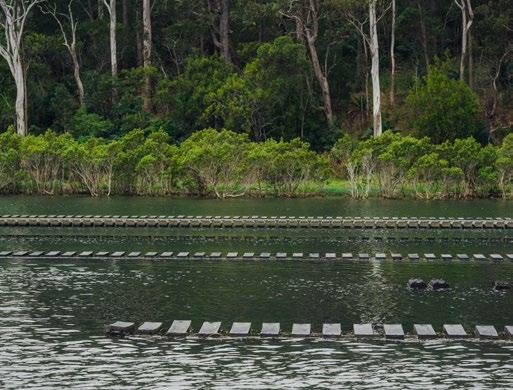
The most recent summer was the first summer season since 2017 that Buckley's farm had been open to harvest. “In 2018, we were closed because we had a rainfall event, which was unprecedented back then because we were in the midst of a drought,” he recalls. “Then, in 2019 we had bushfires that lasted for weeks and weeks. For months we were on constant alert. We had a lot of ash and fire debris in the water, which was no good for the oysters.”
“Every year since, until just recently we’ve had continual floods. I think we’ve had 14 floods in the past three years. The last financial year we had 15 closures to harvest because of rainfall events, so that’s a bit of an indication of how hard the industry’s been hit.”
Last year’s devastating QX disease outbreak in Port Stephens (an area which previously produced about 16 per cent of New South Wales' oysters) also had a huge effect on other farms, which would normally buy spat (oyster larvae) from its hatcheries and nurseries to boost their own populations.
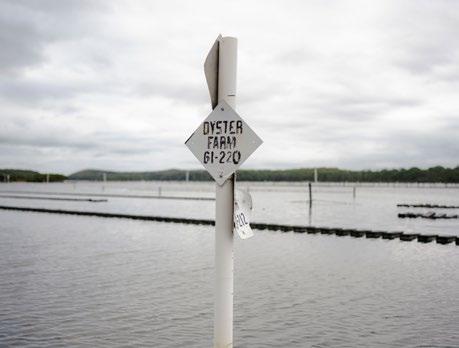

Organisations like Accounting for Nature can help producers such as Buckley calculate, in cold, hard data, the economic value of protecting these waterways, providing farmers with a scientifically robust way of measuring, verifying and certifying changes in the condition of environmental assets—be they native vegetation and fauna, soils, waterways, or other natural capital.
Dr Rachael Marshall says this framework is critical in guiding investment in sustainable land and sea management, enabling natural resource managers, policymakers and investors to link the condition of environmental assets with economic decision-making.
“We currently have 6 million hectares in Australia under environmental account and we’re expecting to double that by the end of 2023,” Marshall explains. “It’s so far been predominantly targeted at the land sector because that’s where the demand has been … but if there was the need to track the condition of the seabed or the area in which the oysters are being leased, that’s how the oyster industry could use this framework. They could measure water quality, seagrass; they could measure turtle numbers,” she continues. “I know there are farms at Moreton Bay where they’re seeing a lot of turtles return to the area, and seagrass and molluscs and juvenile fish; the whole oyster lease is alive.”
It’s a scene rarely pictured when you’re sitting at your favourite bar or restaurant, about to begin the evening’s festivities with a plate of freshly shucked oysters. But it does lend credence to the idea of oysters being the goto pairing for the little celebrations of life, something with which Camorra—whose three MoVida restaurants collectively serve around 100 dozen oysters each week—agrees wholeheartedly. “An oyster and a glass of manzanilla sherry is a match made in heaven,” he says. “And if you’re having a special occasion, it’s like: ‘Let’s start with some oysters, let’s celebrate eating out and just celebrate life in general’.”
Proving that there’s much to explore beyond the classic Champagne match, Melbourne wine importer Campbell Burton serves up some unlikely inspiration for your next oyster pairing.
He says: “Rather than isolating a single wine variety, be guided by style—ideally opting for drinks that mirror the oyster’s structure and flavour profile. Soft, textural wines grown in coastal areas get the tick, particularly those displaying minerality and iodine elements, such as the zesty Carricola Blanco by Celler Tomàs Torres and the Domaine de Kalathas “Sainte Obéissance” from the Greek Cyclades.
An iodine-rich Spanish sherry like the Callejuelua Manzanilla from Marco de Jerez also works well while brut cider such as the Fuente Guijarro Sidra Metodo Clasico from Spain’s Sierra Nevada and the salty, malty Tasmanian-brewed Two Metre Tall Oyster Stout deliver similarly delightful results.”
This season’s MPavilion designer and founder of Bangkok-based architecture practice All(zone), Rachaporn Choochuey embraces the lightness and informality of fabric-based architecture in an effort to foster new and flexible thinking.
– By Isla SutherlandSince the inception of MPavilion in 2014, every year a temporary installation is assembled in Melbourne’s Royal Botanic Gardens, providing a stage for a five-month cultural program that takes place within, beneath and around the commissioned structure.
An ongoing initiative of the Naomi Milgrom Foundation, MPavilion is now in its ninth iteration and, in December, took up residence in Queen Victoria Gardens in the form of a vivid, textural tensile canopy in silken saffron.
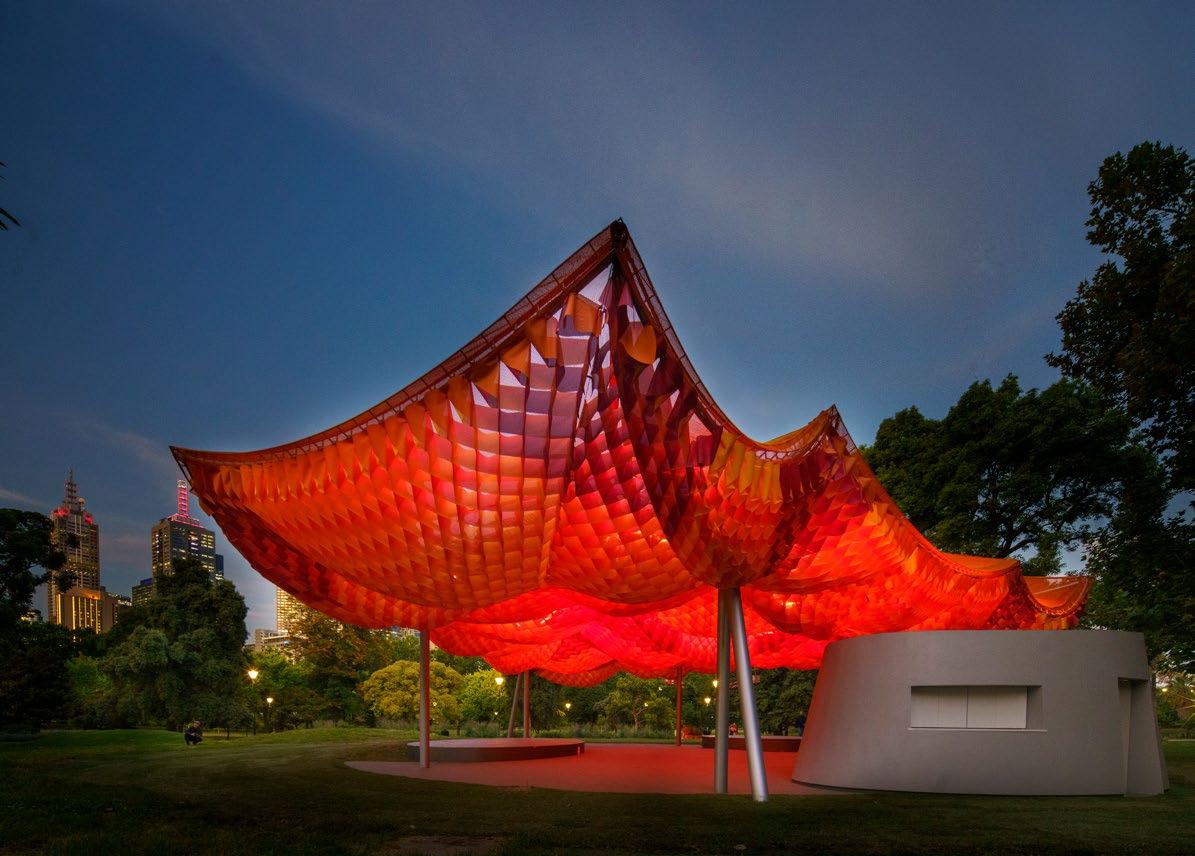
The architect behind the design is Rachaporn Choochuey of Bangkok-based practice All(zone). She says she wanted the pavilion to evoke the experience of sitting beneath a tree, both in the gentle movement of the fabric and the dappled shadows created by the canopy’s waffled underbelly.
The ninth MPavilion is open to the public until 6 April. mpavilion.org
Embracing architecture in its lightest form, the gabled structure appears pitched like a tent on splayed steel legs. A dazzling beacon of light-play and fluidity, the pavilion’s saffron colour was chosen by Choochuey for its resemblance to a Buddhist monk’s robes. The woven underside of the canopy references traditional hanging paper-cut decorations used in Thai festivals. Together, these components have offered a warm and relaxed awning for the suite of art, music and educational events that have been presented at MPavilion over the past months.
The playful, lightweight style is emblematic of All(zone)’s widely recognised architectural interventions, which are informed by Bangkok’s tropical climate and a philosophy of “living lightly”. Since co-founding All(zone) in 2009, Choochuey has worked regularly with this kind of shading architecture, which she sees as the basic typology for tropical living.
“It’s the minimum form of a space that we would think of when we think of something that gives us shelter,” she says. “The porosity in our projects has a lot to do with managing the climate without needing heavy mechanical systems for cooling. We like to use ‘primitive’ techniques for dealing with the conditions, such as shade and natural ventilation.”
The approach has led to great success. The practice was behind the design of Thailand’s first contemporary art gallery—MAIIAM in Chiang Mai—and its work has featured at the Guggenheim Museum, Chicago Architecture Biennial, Vitra Design Museum and Triennale di Milano.
The museum in Chiang Mai was designed with a facade made from thousands of tiny, mirrored tiles, which atomise the building’s solid form into its habitat. “I try to do architecture that blends in with the environment. It has substance, but at the same time, it has this transparency,” explains Choochuey.
All(zone)’s other experiments in shading architecture have included an intricate fabric roof for the Sharjah Architecture Triennial, or the woven “marmalade sky”— a temporary, transparent magenta shade that lightly dyes the horizon—for Bangkok’s Wonderfruit Festival. Working on temporary architecture projects has afforded Choochuey the opportunity to experiment with unconventional expressions, regularly playing in fabric-based architecture, using local and upcycled materials ranging from fishing nets to silk offcuts to create approachable, irreverent and functional spaces.
But fabric architecture, Choochuey explains, comes with its own unique set of challenges. “The software we have now deals with architecture as a rigid element, like brick walls, concrete floors, glass and steel—but not as soft material,” she says. “It’s impossible to create the effect of these materials in our current architectural software.”
In creating the MPavilion, for example, Choochuey and her team had to rely on scale models in order to understand how the fabric would behave and to grasp the true essence of its material form. A prime example of a simple premise with complex resolution, Choochuey’s MPavilion experiments with forms and materials likely never used before in Australia.
The canopy comprises three layers: an outer layer of fishing nets, giving the appearance of transparency from afar; a middle waterproof layer crafted from an innovative polyacrylate membrane, as transparent as glass but far lighter; and a perforated filter layer which generates the dappled shadows.
While the sustainability of temporary architecture might seem questionable, Choochuey says working with lighter structures enables the possibility for modification where more unyielding structures would be demolished.
“What we try to do conceptually is imagine a design that would allow things to change,” she says. “In this case, with the MPavilion, it is very clear that its first life will be these few months in Queen Victoria Gardens. Then it will be relocated, where it will stay for another 20 years.”
As Choochuey rightly identifies, the MPavilion will likely outlive many of today’s contemporary buildings. More than that, the light-touch design remains open to future adaptations and possibly even new, unexpected uses.
The adaptability of Choochuey’s temporary architecture prototypes can be seen across a number of All(zone)’s projects. In Lighthouse, an ongoing experiment in low-income housing solutions with “less rigid materiality and energy”, the approach is applied to the problems of housing affordability and human security. These micro-dwellings made from a metal grid and walls of nylon netting can be assembled in just four hours within abandoned lots and unutilised buildings.
During the peak of the pandemic, All(zone)’s temporary architecture solutions also helped address the domestic transmission between hospital workers that was being exacerbated by substandard living conditions. Choochuey hopes her temporary architecture might help us to consider a wider repertoire of materials and methods, as well as revise our social credo for permanence in buildings that can ultimately, in some cases, result in the opposite, given that such buildings are often demolished when they are no longer wanted or considered fit for purpose.
While Choochuey speaks somewhat sceptically about the necessity of her commission during a time of global upheaval, her design could not be more timely. After suffering the longest pandemic-related lockdown of anywhere in the world, Melburnians have come to rely on their public outdoor spaces more than ever. All(zone)’s structure is a welcome injection of colour and community that enables the celebration of culture and togetherness in the outdoors.
“When we started thinking about the pavilion, we were thinking about the need to see people again,” Choochuey says. “We had just gotten out of the peak of Covid. It was really bad in Thailand in mid-2021. We knew we didn’t want to be in a room with walls or confined to a small space; it should be a place to celebrate public life.”
This desire for unconfined gathering spaces is reflected in the design’s deliberate lack of tension. Its loose, billowy form embraces the lightness and informality so courted by the community after the tumult of these past few years. Choochuey shows us how her style of pared-back architecture leaves space for people and poetry, redefining the juncture at which a structure becomes a container for human life.
Deliberately leisurely journeys are the ultimate antidote to the frantic rush of modern life. Now a new generation of immersive experiences is changing the way we travel.
 –
By Leanne Clancey
–
By Leanne Clancey
But with all that has changed in the world over the past few years, newfound priorities have shifted the ways that many people choose to travel. A discernible move away from the frantic energy that fuelled pre-pandemic vacation trends has led to a proliferation of niche operators specialising in a slower style of travel, ranging from unhurried river cruises and luxe sleeper train journeys to exclusive homestays and hands-on paddock-to-plate experiences. By embracing the old-world glamour of train travel, for example, or appreciating longer and more immersive stays in single destinations, a growing number of travellers are trading a box-ticking mentality for a deeper sense of connection to new places and people.
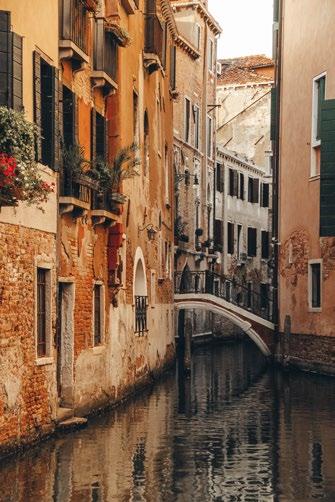
So, what exactly is slow travel? Rather than a strict prescription, this type of travel is a mindset that can be categorised into two key notions: the first being flight-free travel—swapping carbon-heavy plane journeys for modes of transport that are not just gentler on the environment (think trains and vessels) but also pleasure-filled experiences in themselves. The second concept is about how we relate to the places we visit and the attitude we bring. Rather than skimming through a well-worn hitlist of over-touristed sights, slow holidays encourage taking the time to connect with locals and understand a destination’s culture, food and lifestyle in ways that go beyond a transactional tourist-host dynamic.
London-based Imogen Lepere, author of two books on ethical travel and a reporter of slow travel experiences for publications including The Financial Times and Conde Nast Traveller, says a conscious travel mindset offers numerous benefits. “For me, slow travel provides a far deeper understanding of a host culture than just seeing the sights,” Lepere explains. “Slow travel facilitates meaningful interactions with locals, which I think should always feel like an exchange rather than one-way traffic.”

For some, just seeing the words “slow” and “travel” in the same sentence might induce a mild shudder, conjuring visions of crowded trains or a renunciation of modern comforts. So mired have we become in the culture of travel hacks and bucket lists, choreographing holiday schedules down to the very last Instagrammable minute, that the idea of doing it all at a pace that would allow for breathing space seems almost decadent.01. Interior of the new Orient Express La Dolce Vita train, which will journey the Amalfi Coast, the alps and some of Italy's most historic cities when it launches in 2024.
She adds that when you travel with a slow mindset, the exchange becomes less self-regarding and more reciprocal. “Travelling slowly provides many more opportunities to give back than other forms of travel, which ultimately makes the experience far more meaningful,” she suggests. “Sure, you are there to immerse yourself in a new culture, but you can also bring ideas from your own through music, food, conversation… This can be really expansive for locals, particularly if you’re visiting a remote region where few people have had the opportunity to travel overseas.”
Cat Jones, founder of bespoke tour operator Byway, agrees: “Travelling by train, boat and bike, we slow down to appreciate lesser-known locations, bypass touristy hotspots and feel like we’re discovering the world on our terms.” Specialising in flight-free holiday packages away from the usual tourism trails, Byway has gained traction since launching in 2020 by showcasing the joy of slow travel while taking the hassle out of no-fly travel logistics.
Jones believes the pandemic years helped people understand the impact of supporting local and that has extended to travel preferences in support of local economies rather than contributing further to the issues that come with heavy visitation.
The argument for flight-free travel can be compelling when you crunch the carbon offset numbers. “You could get the train from London to Edinburgh and back five times and your carbon footprint would still be lower than if you flew there,” Jones points out. “Giving up meat for a year
saves 2.7 tonnes of carbon while giving up one return flight from London to Bangkok saves 3.3 tonnes.”
In a 2022 user survey by US-based travel agency network Virtuoso, 74 per cent of respondents stated they were willing to pay more to travel sustainably if they know where the money is going and agreed that travelling sustainably enhances their holiday experience. This extended to seeking out companies and experiences that focus on “preserving natural and cultural heritage”, in alignment with the slow travel ethos.
Jones adds that, beyond the social and environmental benefits, flight-free travel is often “more interesting and less stressful”. Rather than getting from A to B as quickly and simply as possible, flight-free travel encourages you to customise a multi-stop adventure, gliding through places that planes cannot access and serving up vistas you would normally miss, with more legroom to boot. Additionally, check-in and security processes tend to be quicker at train stations and boat terminals than at airports.
Train travel, in particular, has experienced exceptional growth in the past few years. “We are past the era of fast, frequent travel and guilt-free consumption,” explains Gary Franklin, from luxury hospitality operator Belmond, which owns the Venice Simplon-Orient Express. “Today’s discerning travellers are looking for meaningful, slowerpaced, sustainable and immersive experiences and train travel is arguably the most romantic and charming way to reach [your chosen] destination.”
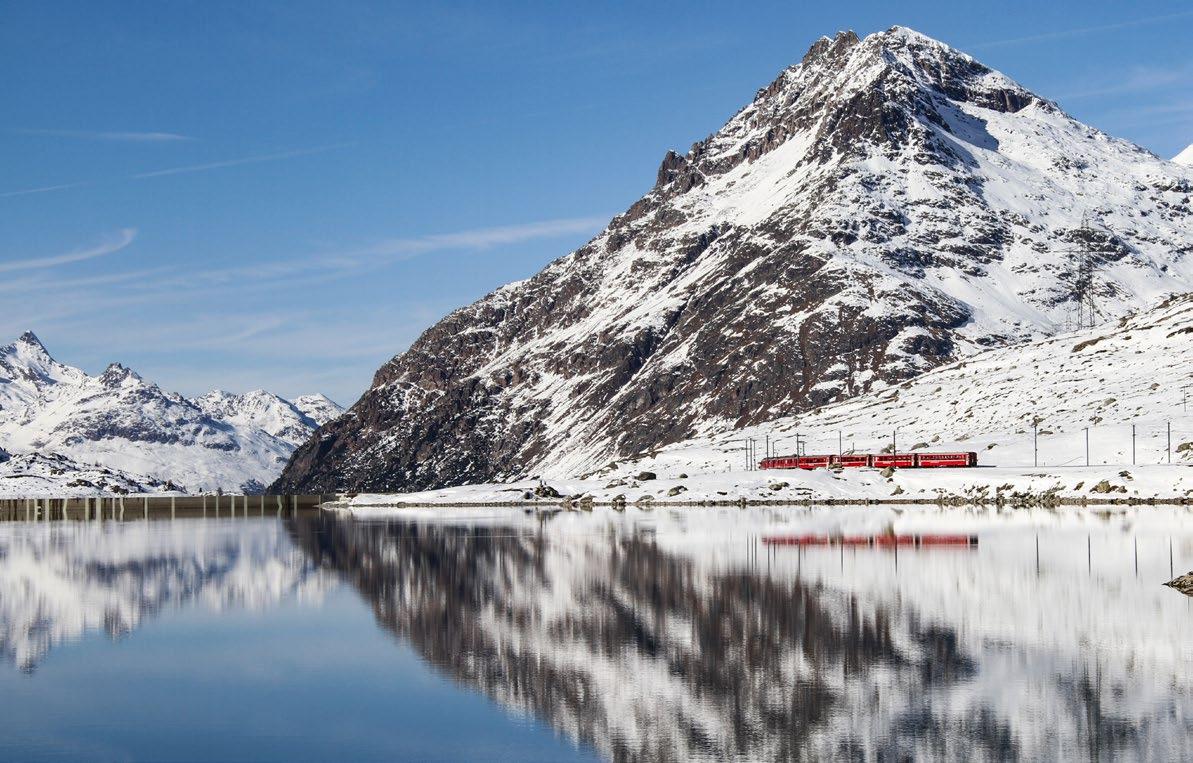
Bookings on the Venice Simplon-Orient-Express (whose dining experience comes via French chef Jean Imbert of Plaza Athénée fame) and Royal Scotsman luxury trains are up 20 per cent and 35 percent respectively on pre-pandemic figures, says Franklin. Meanwhile, Belmond’s British Pullman—which features the 1950s-era Cygnus carriage delightfully redesigned by filmmaker Wes Anderson—has grown its clientele by a whopping 40 per cent.
In Europe, the iconic Orient Express (unrelated to the Venice Simplon-Orient-Express), which debuted in 1883 for journeys from Paris to Istanbul, is set to launch a new service taking in 14 Italian regions next year. The joint venture by France’s state rail company SNCF, hospitality group Accor and Italian property investment company Arsenale focuses on exploring lesser-known parts of the country. Featuring mid-century-inspired interiors by Milan-based design firm Dimorestudio (whose client list includes Dior, Fendi and Hermes), the La Dolce Vita service will also offer international journeys from Rome to Istanbul, Paris and Split—with bespoke excursions such as truffle hunting in Piedmont available along the way.

According to social media giant Pinterest, the search terms “train trip aesthetic” and “train quotes travel” rose by 205 and 285 per cent respectively in the past year. “Train bragging” has also become part of the platform’s lexicon thanks to users flaunting images of their exotic rail adventures.


Around the world it appears a rail renaissance is taking shape, with new tech-enabled trains promising experiences that range from super-comfortable to ultra-luxurious. This includes sleeper trains, which are increasingly billed as a climate-friendly alternative to shorthaul flights for both business and leisure travellers. Later this year Austrian national rail operator OBB will roll out 33 next-gen NightJet sleeper trains to elevate comfort for those connecting to the European railway hub of Zurich Hauptbahnhof. Recent upgrades have also raised standards and shortened travel times between Oslo and Stockholm, with five services now running each day.
On the water, meanwhile, Orient Express will launch its first cruise in 2026 having commissioned a 220m sailing yacht from Chantiers de L’Atlantique with capacity for up to 120 passengers. The wind and LNG-powered vessel is set to join a new strand of hotel-yacht hybrids taking to the seas over the next couple of years, with luxury resort groups such as Four Seasons and Aman also investing in floating sanctuaries that deliver high-end hospitality with a greater degree of structure than a private charter.
In this exciting new era of travel, the nostalgic gilded-age charm of trains and boats is being reimagined with a modern, green, techforward edge—offering travellers the best of both worlds.

The enigmatic LSO and multi-award-winning conductor Sir Simon Rattle—in his final season as music director—will join Melbourne’s own symphony orchestra for a one-night program of unmissable performances this May. For the first time in nine years, Hamer Hall will be filled with the musical alchemy of three signature pieces: John Adam’s Harmonielehre, a symphonic performance of a 114-strong orchestra; Debussy’s La Mer, a masterpiece exploring Greek myth; and Ravel’s Daphnis et Chloé Suite No.2 Arts Centre Melbourne, 5 May. mso.com.au


Part of Sorrento’s revamped Continental Hotel, the new Aurora Spa & Bathhouse offers countless inspired ways to soak and recharge. Start by submerging in magnesium-enriched pools (designed to detoxify the body through transdermal absorption), experience the Nordic-inspired chill of the glacial mist room, then retreat into the warmth of the sauna (the largest in the southern hemisphere). The menu also includes various traditional and revolutionary spa treatments, including sensory showers and halotherapy rooms for soothing tense joints or muscles. 23 Constitution Hill Road, Sorrento. auroraspa.com.au
Four years in the making, this international-exclusive exhibition charts the five-decade-long career of late Sydney fashion icon Carla Zampatti—from her debut collection in 1965 until her death in 2021. Celebrating the Italian-born designer’s trailblazing career, the retrospective focuses on rare and archival pieces including more than 100 outfits and personal items, as well as video and audio installations of intimate conversations between family, close friends, clients and industry contemporaries. A must-see for fashion lovers, the exhibition renders the life and legacy of Zampatti’s career in remarkable detail. Powerhouse, Sydney, until 11 June. maas.museum
To mark its 60th anniversary this year, The Australian Ballet will present a lively adaptation of Don Quixote for Melbourne and Sydney audiences this autumn. Inspired by Rudolf Nureyev and Robert Helpmann’s 1973 film and adapted for the stage, this wildly spirited piece will employ the film’s lush aesthetics to immerse audiences in multisensory beauty. Brimming with contagious energy, the performance promises a true stage spectacular with a generous dose of Spanish verve. Playing 15-25 March at Arts Centre Melbourne and 8-25 April at Sydney Opera House. australianballet.com.au


Opening this month, Capella Sydney marks the first Australian outing for the Singapore-based Capella Hotel Group. Set in the heritage-listed former Department of Education building a short stroll from Sydney Opera House, the hotel houses 192 generously sized rooms and suites across eight levels. Ground-floor restaurant Brasserie 1930 (helmed by Brent Savage and Nick Hildebrandt of Bentley and Monopole fame) will serve modern takes on brasserie classics, while guests can also enjoy the cocktail-focused lounge bar, art-filled culture spaces and immersive health spa. Sandstone Precinct, Sydney. capellahotels.com/sydneyau
Curated by Samoan artist and curator Dr Léuli Eshrāghi, the 9th TarraWarra Biennial will feature an exhibition of newly commissioned works from 15 artists and artist groups examining concepts of past, present and future. Titled ua usiusi fa’ava’asavil (a Samoan proverb that translates to “the canoe obeys the wind”), the exhibition looks at traditional celestial navigation practices and the interconnectedness of the various lands, waters and humans that make up what is now recognised as Australia.
TarraWarra Museum of Art, Healesville. 1 April-16 July. twma.com.au

 Visual Art TARRAWARRA
Visual Art TARRAWARRA


Audiences will be offered a revealing glimpse into the life and mind of Andy Warhol in a new exhibition at the Art Gallery of South Australia. The iconic artist’s career-long obsession with photography is put on display in the strikingly candid retrospective, demonstrating the power of the image in shaping both his public persona and self-image. The exhibition captures the atmosphere of Warhol’s 1960s heyday, exploring the dynamic between sexuality, fame and perception via his art, self-portraits and penchant for photographing his celebrity contemporaries. AGSA, Adelaide. 3 March-14 May. agsa.sa.gov.au
Three-Michelin-starred Côte d’Azur fine diner Mirazur, which took out top spot at the World’s 50 Best Restaurants awards in 2019, lands in Sydney this March for an unprecedented three-week popup. Part of a program that will see chef-owner Mauro Colagreco and his team travel to multiple cities around the world seeking new inspiration, the residency at Pier One’s The Gantry will present Australian diners with a rare chance to experience the Italian-Argentine chef’s culinary magic through a multi-course tasting menu designed around meticulously sourced Australian produce. The Gantry, Sydney. 10-31 March. chefworldtour.com

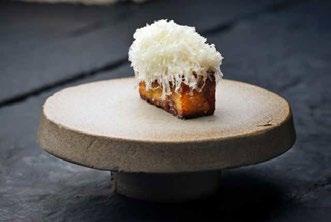

Acclaimed chef and sustainable seafood champion Josh Nyland and wife Julie Nyland are set to open their fourth venue, this time on Sydney’s lower north shore. Focusing on ethical produce from both land and water, Petermen will offer a more casual, flexible alternative to the pair’s two-hat flagship, Saint Peter in Paddington (which is set to relocate to Paddington’s Grand National Hotel later this year). Sunday brunch and a share-friendly à la carte menu will feature at the 60-seater, along with bar seating for walk-ins. St Leonards, Sydney. petermen.com.au
Opening this April, ACMI presents the world premiere of Goddess: Power, Glamour, Rebellion, an immersive exhibition saluting the formidable and revolutionary leading ladies of film. Charting over 120 years of moving image history, Goddess examines the changing representations of femininity over time, and the provocative on- and off-screen moments that have shaped our screen culture. A compelling chronicle of cinema archives, Goddess features video installations and interactive experiences alongside never-before-seen costumes and other cinematic treasures including garments worn by the likes of Mae West and Marilyn Monroe. ACMI, Melbourne. 5 April-1 October. acmi.net.au
Pioneering restaurant L’Enclume is set to decamp from northern England to Sydney this winter for a five-week residency at the Bathers’ Pavilion on Balmoral Beach. After scoring three Michelin stars in 2022, chef Simon Rogan will bring select members of his home team along for the excursion, applying his visionary paddock-to-plate ethos to Aussie ingredients for an eight-course degustation. With places for only 80 attendees per sitting, this will be one of the year's most in-demand bookings. Bathers’ Pavilion, Balmoral. 19 July-20 August. batherspavilion.com.au
The Terrace at Melbourne’s Royal Botanic Gardens has undergone an impressive transformation under the stewardship of new operator Darling Group (Top Paddock, Higher Ground, Stringers), delivering an all-new destination cafe with those same lakeside views. The licenced cafe’s Med-leaning allday menu features a range of classic brunch dishes and produce-driven lunch selections alongside seasonal takeaway and picnic-ready options. Botanical-inspired interiors by design studio Technē bring the outdoors in, while the leafy outdoor terrace demands a leisurely spritz. The Terrace, Melbourne (via Gate A at Alexandra Ave & Anderson St). theterrace.melbourne

